Maryland may be a smaller state, but it has a lot to offer, especially for birders.
Maryland’s Department of Natural Resources says there are over 450 unique species of birds that have been identified in the state, and more than half of those are nesting-season birds.
Whether you live in the state or are visiting, you have the opportunity to see some gorgeous, unique, and fascinating birds here!
There are dozens of kinds of ducks that call Maryland home, although most are only here in the winter. Some come through as migrants, and a few stick around all year. If you’re interested in identifying ducks, you’ve come to the right place!
Our list includes 27 of the most common ducks in Maryland, including tips on where to find them and how to identify them.
How to Identify a Duck
To identify a duck, you will use a lot of the same skills that you use when you’re identifying other birds.
That includes taking note of the following:
- Size (wingspan, weight, length)
- Shape (silhouette)
- Coloring
- Patterns
- Unique behaviors
- Diet
- Habitat
- Migration patterns
You’ll also need to know the differences between the two main kinds of ducks: dabbling and diving ducks.
Dabbling Ducks vs. Diving Ducks (And Sea Ducks, Too!)
A dabbling duck doesn’t submerge itself underwater in order to gather food. Instead, it just submerges its head and leaves its tail feathers pointed at the sky.
A diving duck, on the other hand, will dive all the way under the water and re-surface a little later. Sometimes, divers will go as deep as 200 feet under the water! (Maryland has one of these deep-divers: the Long-Tailed Duck.)
Sea ducks are a subcategory of diving ducks. They are divers, not dabblers, who live almost exclusively in saltwater habitats and are built to withstand the waves and rocks of the ocean.
Our list includes 27 ducks, including some dabblers and divers. We’ve labeled sea ducks as such, too, to help you quickly differentiate between the ducks you encounter in Maryland.
American Black Duck (Dabbling Duck)
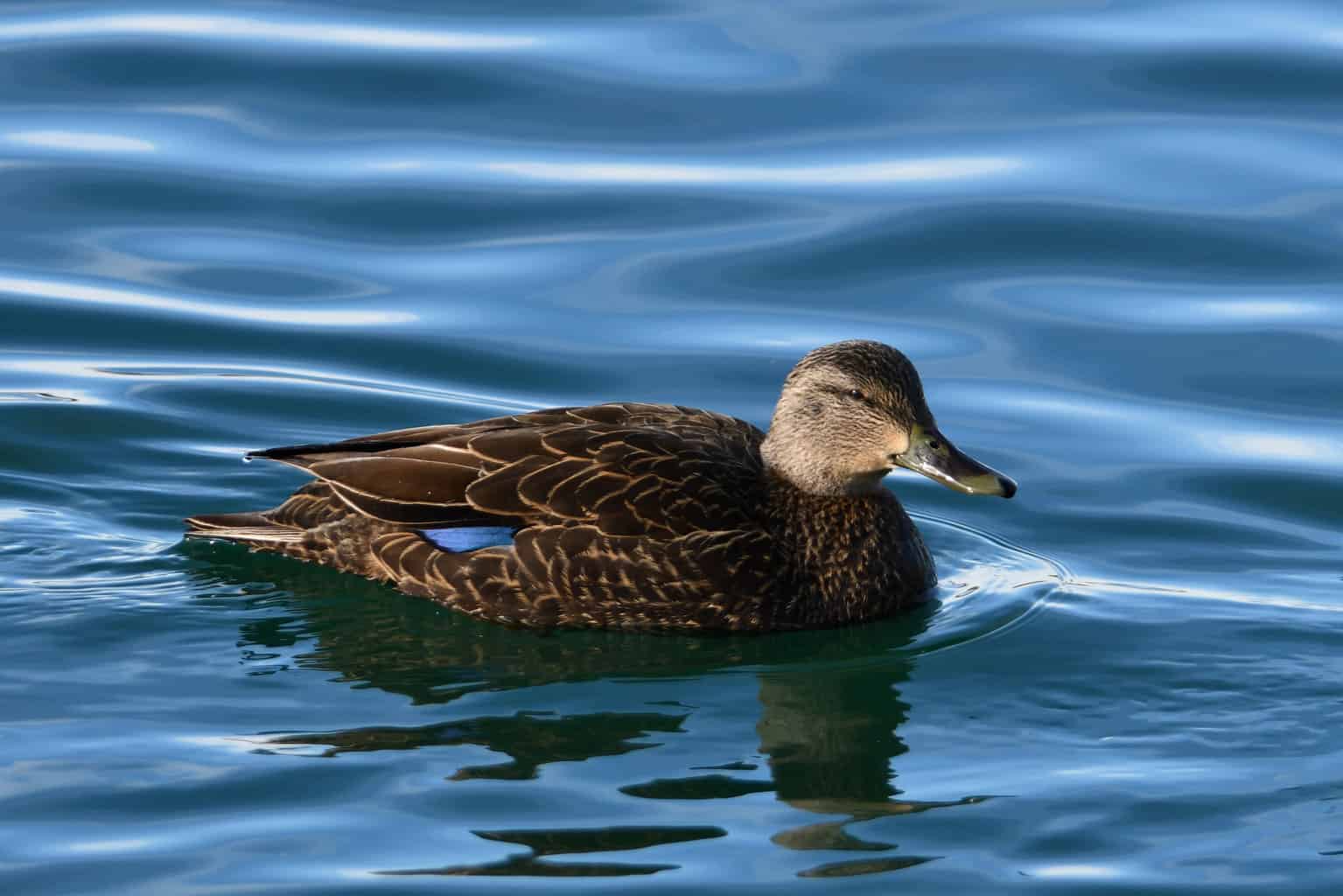
- Anas rubripes
- Length: 21.3-23.2 inches
- Weight: 25.4-57.9 ounces
- Wingspan: 34.6-37.4 inches
American Black Ducks are almost exclusively found in the North American east, which means Maryland is right in the heart of their year-round territory.
It is especially plentiful around the Chesapeake Bay, where it inhabits tidal wetlands and nearby rivers.
Their breeding season begins in the middle of March, and these tree cavity-dwellers often nest along the Potomac River, Rappahannock River, York River, and James River.
The male American Black Duck has a dark brown body and a bright blue speculum. A duck’s speculum is often only visible in flight, and that is true with the Black Duck, too.
Sometimes, they are confused with Mallards, as the male Black Duck has a feather pattern that is similar to the female Mallard. One easily-detectable difference is the male Black Duck’s yellow bill, which is different from Mallard’s orangeish-gray bill.
Females are slightly lighter brown, with a green bill.
Deforestation has affected the Black Duck’s habitat. Their preference for wooded habitats has been unsustainable due to extensive tree removal in some parts of its territory.
American Wigeon (Dabbling Duck)

- Mareca americana
- Length: Up to 14 inches
- Weight: About 2.25 pounds
- Wingspan: 34 inches
American Wigeons are winter residents of Maryland, typically arriving by October and leaving by April. Some, of course, will arrive early or leave late.
Although they are found throughout the state, Cambridge boasts the most sightings on record.
An American Wigeon male’s most distinguishable trait is the iridescent green band that starts at his eyes and angles backward. His body is light brown, and he has black wing tips and a black tail. He also has a black-tipped, blue-gray bill.
Female American Wigeons are light brown, and their heads are dappled in gray. The female’s eyes are dark, and her bill is black-tipped like the male’s bill.
Their winter habitat includes quiet lakes, rivers, bays, agricultural fields, estuaries, reservoirs, and tidal areas, as long as there are plentiful aquatic grasses and plants.
Black Scoter (Diving Duck)
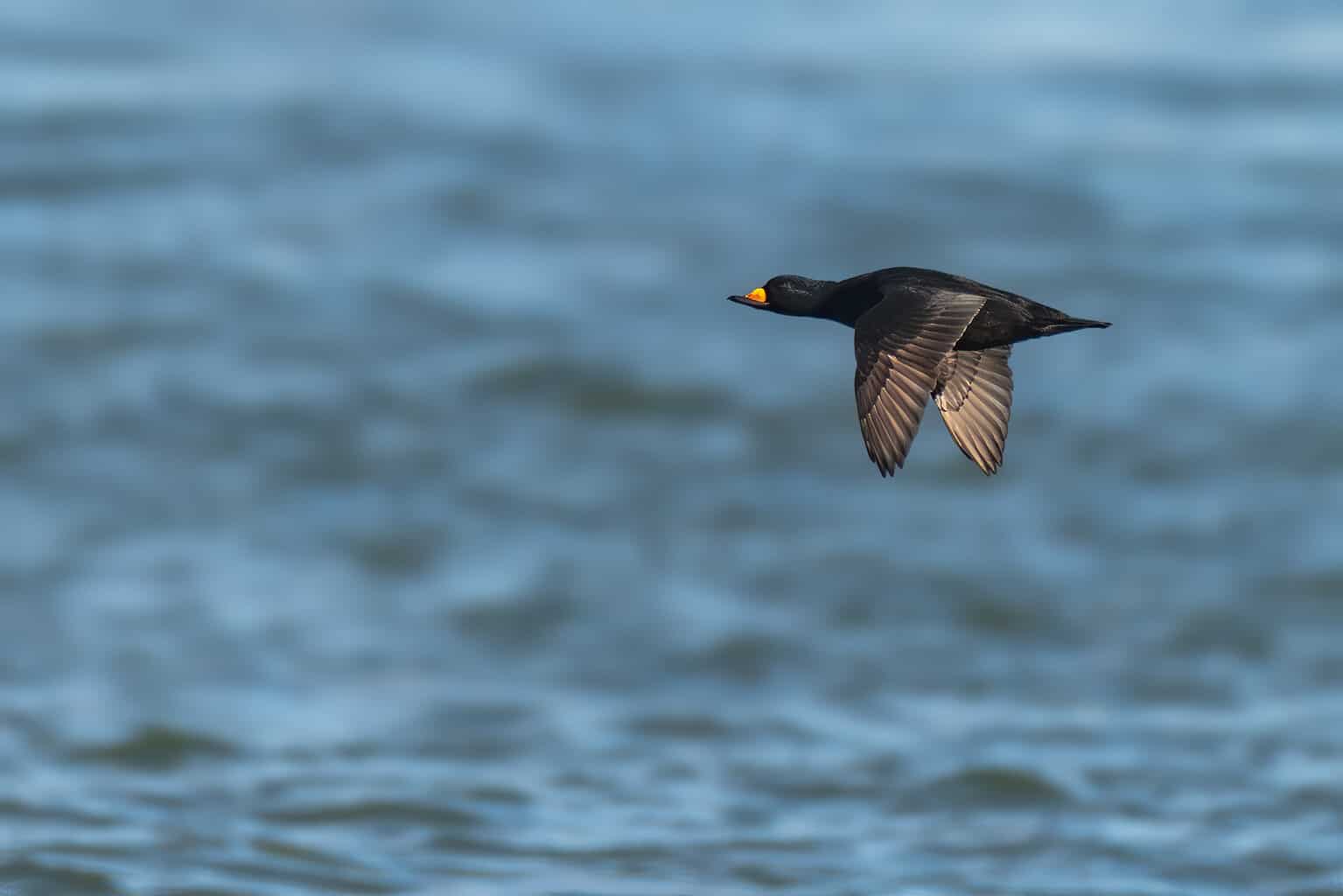
- Melanitta Americana
- Length: 127 – 21 in (43 – 53 cm)
- Weight: 387.4 oz (1088 g)
- Wingspan: 30 – 35 in (76 – 89 cm)
Black Scoters spend the winter on the Pacific and Atlantic Coasts after breeding in Alaska or Northern Quebec. There have been some sightings in Maryland in the summer, but for the most part, Black Scoters arrive in the state in October and leave by May.
They stay near the coastline where the waters are pretty shallow. Their diet includes mollusks, shrimp, and other shellfish, as well as fish eggs and larvae.
Black Scoters are almost immediately identifiable thanks to the orange bulge at the base of his otherwise black bill. His feathers, legs, and eyes are all black.
Females are light brown and mottled. They have a dark brown crown and gray cheeks. Unlike the male, the female’s bill is all black.
Blue-Winged Teal Duck (Dabbling Duck)
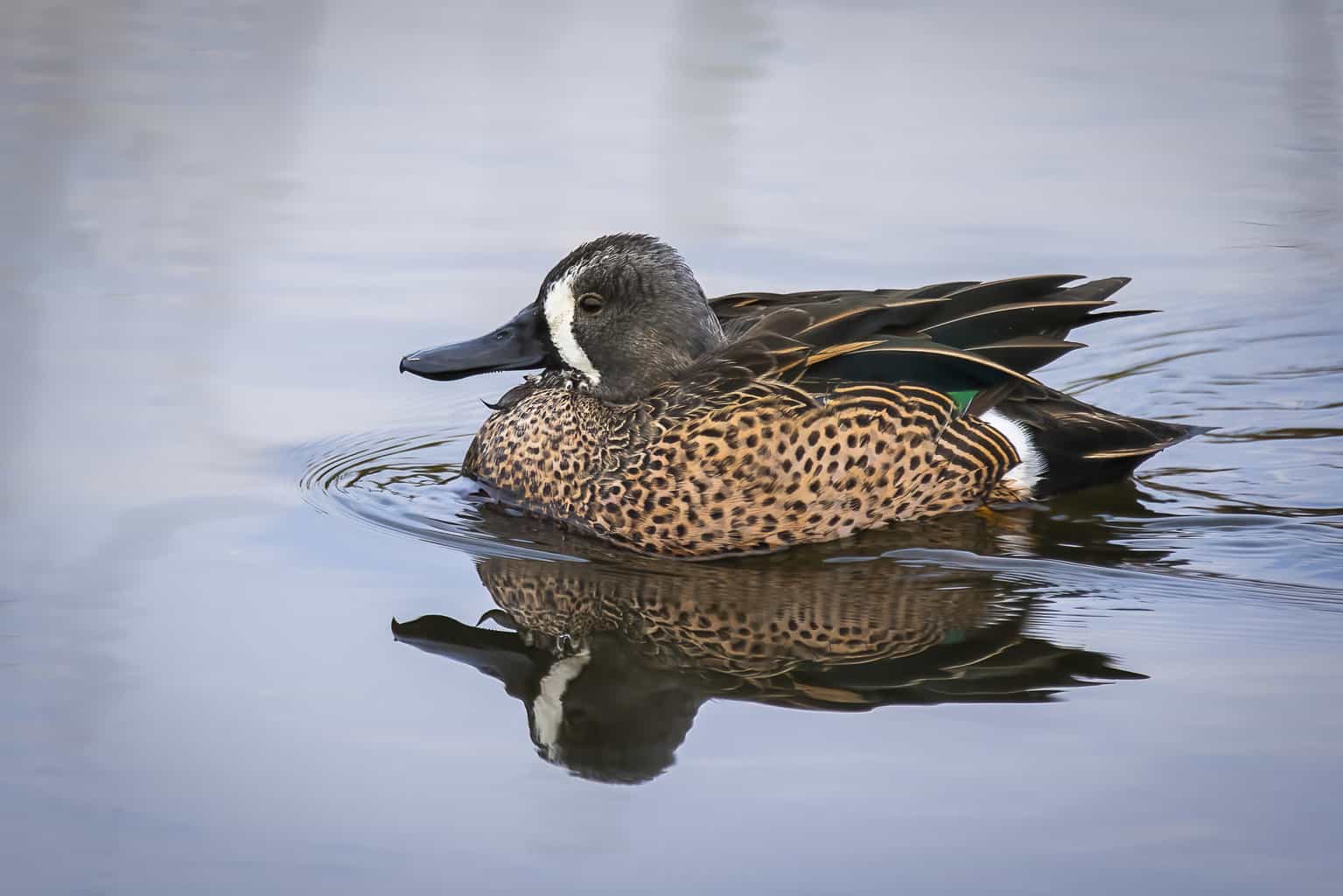
- Spatula discors
- Length: 15 – 17 in (38 – 43 cm)
- Weight: 19.18 oz (544 g)
- Wingspan: 23 -31 in (58 – 79 cm)
Blue-Winged Teal Ducks have been spotted in Maryland all year around, but they are mostly migratory visitors. A small number spend the summer on Maryland’s coast. They live in grassy areas near calm waters, like small ponds and marshes.
The male Blue-Winged Teal Duck’s head is gray, and his body is brown and mottled. He has a black back, a large white crescent shape right in front of his eyes, and a blue shoulder patch. He also has an iridescent green speculum.
The female is speckled in light and dark brown. She does not have the male’s facial markings.
An unfortunate fact is that Blue-Winged Teal Ducks have unusually high mortality rates, likely the result of damage they suffer during their long migrations. Some of these ducks will travel all the way between Canada and South America when they migrate.
Bufflehead (Diving Duck)
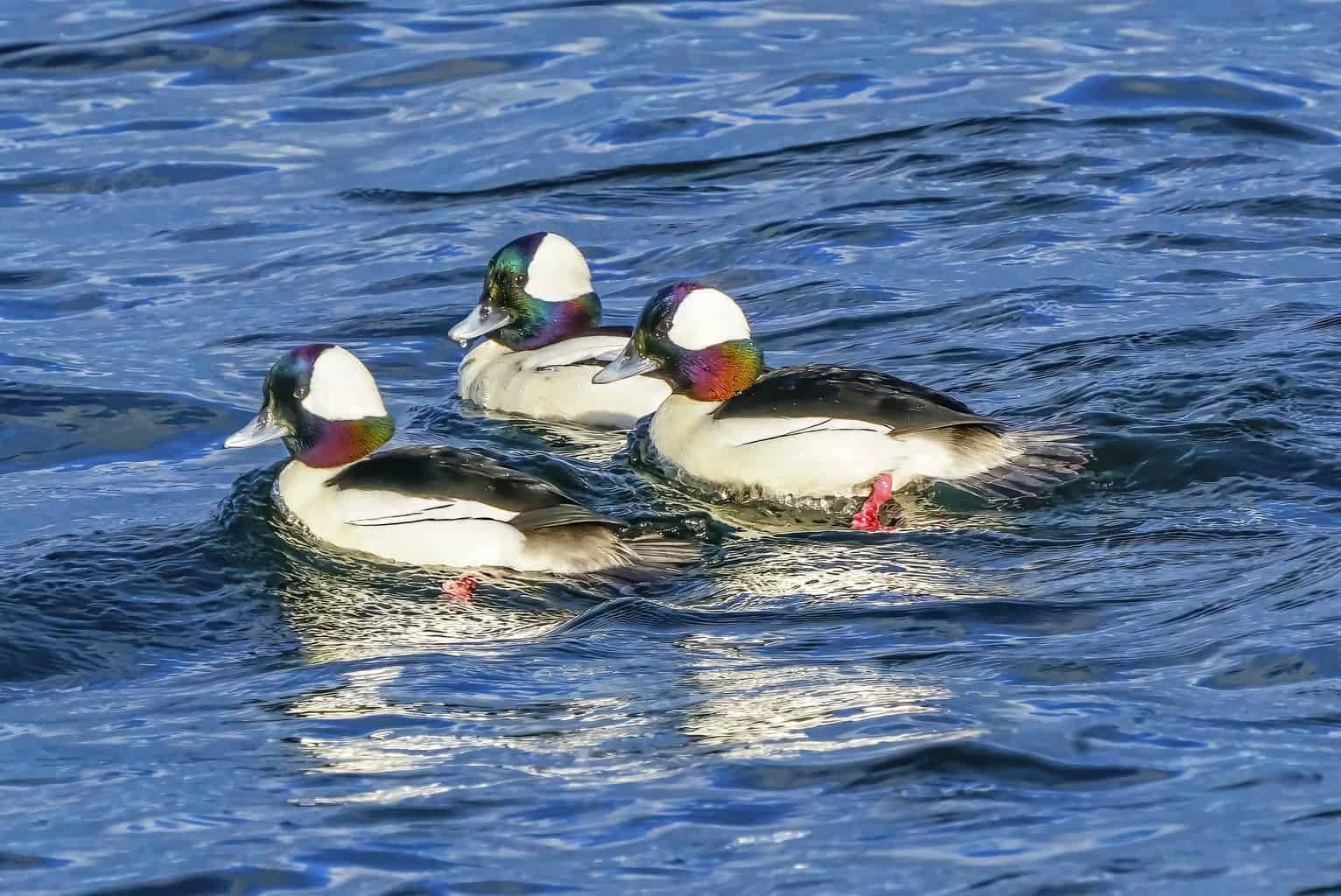
- Bucephala albeola
- Length: 13 – 16 in (33 – 41 cm)
- Weight: 21.16 oz (600 g)
- Wingspan: 22 in (55.8 cm)
Buffleheads are winter residents throughout Maryland. They are plentiful throughout the Chesapeake Bay, where they have a diet that consists of seeds, small fish, and aquatic plants and insects.
Most will arrive by November and depart by April.
Buffleheads get their name from their large, round heads. Males have a slick-looking, iridescent green and purple head with a large, white, fan-shaped patch around the back of the head.
Females have two distinctive white patches: one on their wings and one on their cheeks. Otherwise, they are gray-brown with a gray-white chest.
Their legs are set far back on their body, which makes them awkward and clumsy on land.
Buffleheads live in tree cavities, but they are also drawn to nest boxes. To increase your chance of seeing Buffleheads during the winter, you can purchase or DIY a nest box to put on your property.
The important thing is that you live near one of their preferred winter habitats, such as estuaries, sheltered coastal bays, inland ponds, lakes, and slow-moving rivers.
Canvasback (Diving Duck)
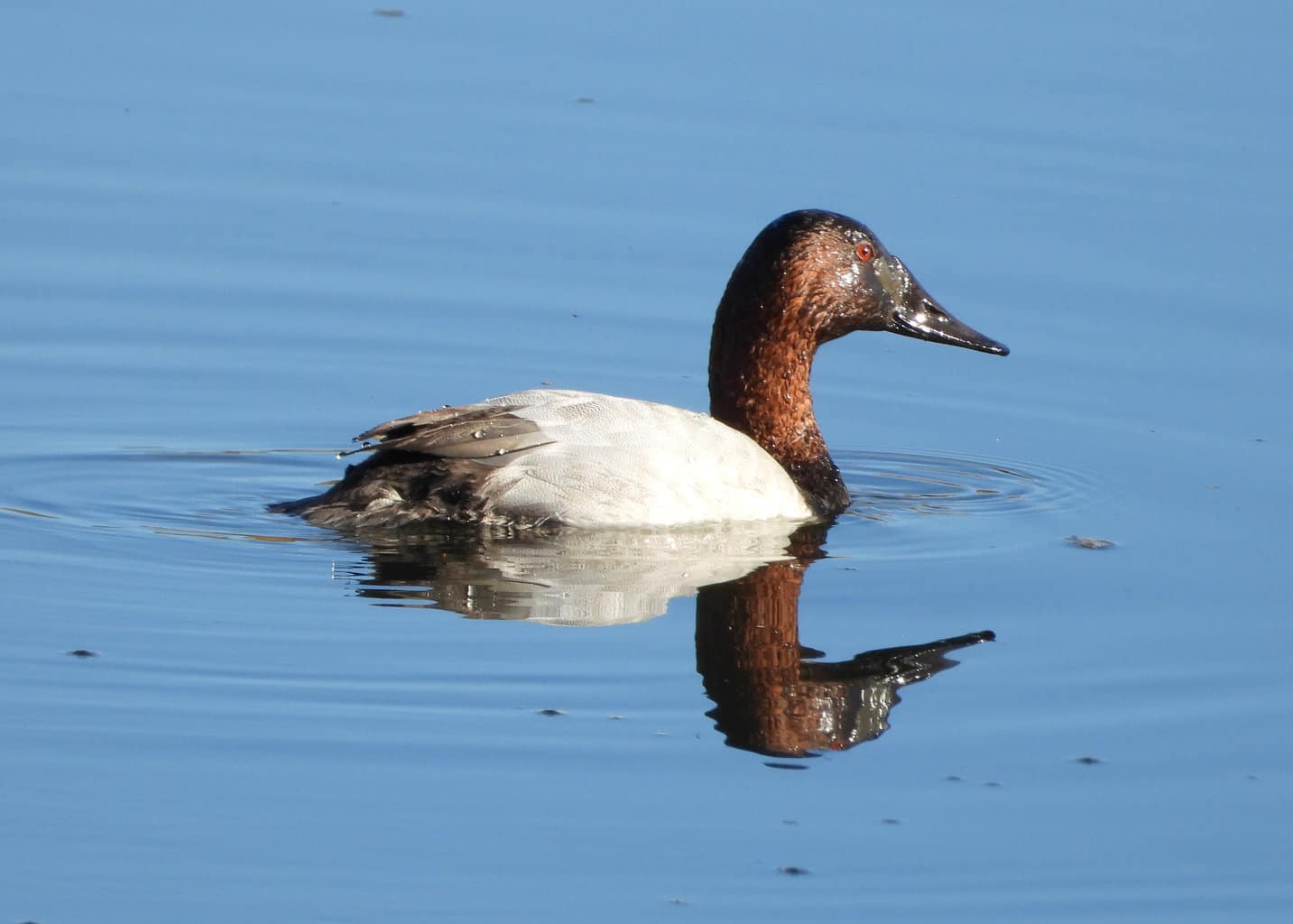
- Aythya valisineria
- Length: 19 – 24 in (48 – 61 cm)
- Weight: 58.48 oz (1657 g)
- Wingspan: 28 – 36 in (71 – 91 cm)
Most Canvasbacks arrive in Maryland between November to December and stay in the area until April. They are common sights in the Chesapeake Bay’s wide tributaries, where they feed on wild celery, aquatic grasses, leaves, snails, clams, and insects.
The Canvasback is the largest diving duck in North America.
Males have a sloping, dark reddish-brown forehead and a canvas-gray body. His black bill is thick and broad. He also has black tail feathers and red eyes.
Females are similarly patterned, but their coloring is muted in comparison. They have black eyes.
Common Eider (Sea Duck)
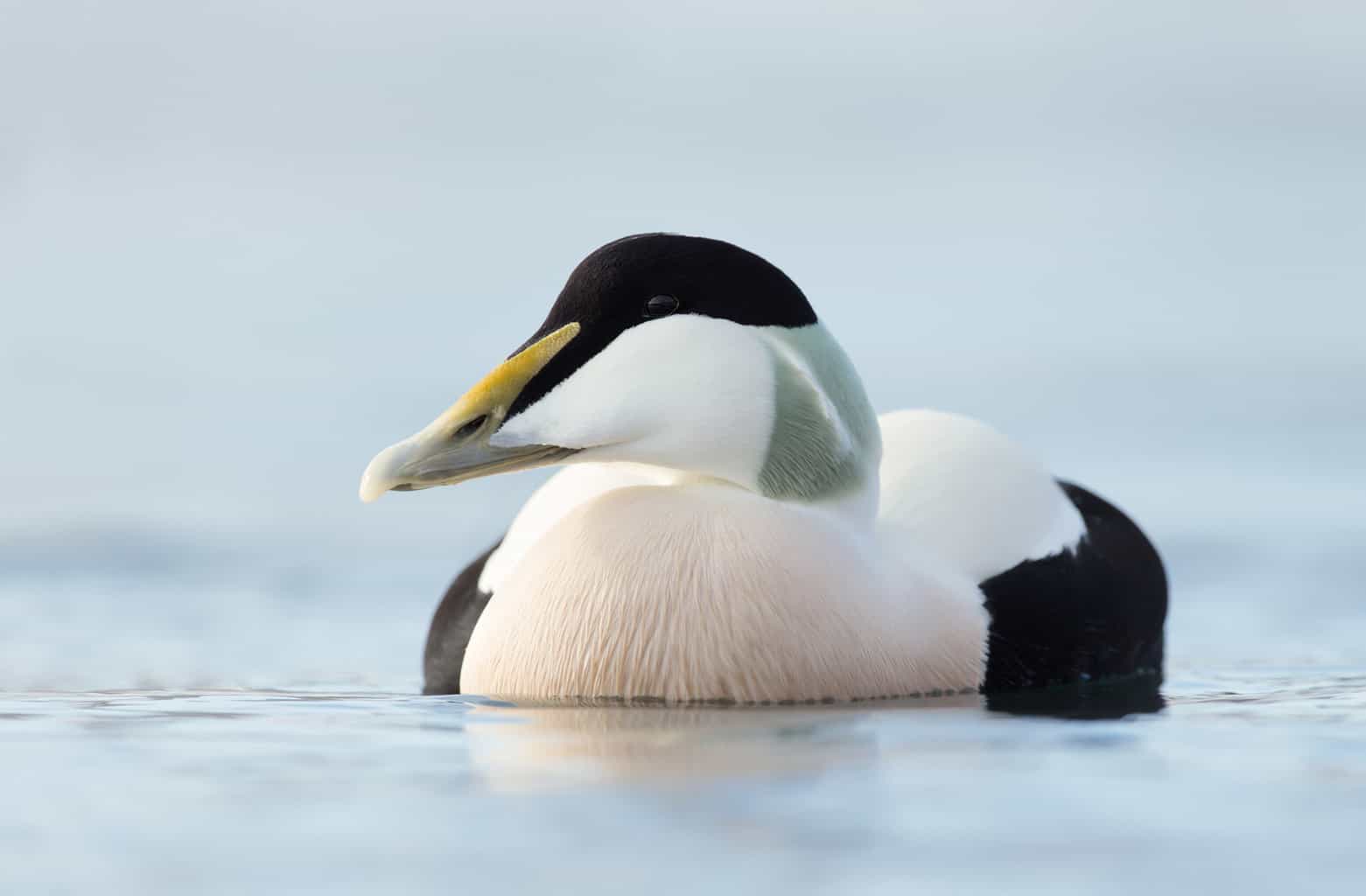
- Somateria mollissima
- Length: 19.7-28.0 in (50-71.1 cm)
- Weight: 45.9-92.1 oz (1300-2611 g)
- Wingspan: 37.4-38.6 in (95-98 cm)
Both Common Eiders and King Eiders are present in Maryland, but Common Eiders are seen with much more frequency.
These stunning ducks live in ocean bays, inlets, and estuaries. Most of the sightings in the state have been of females and juveniles.
Common Eiders have only been spotted in a few places in the state: near Ocean City and Point Lookout.
The male Common Eider is mostly black and white. His forehead slopes down to his bill at a dramatic angle, and he has light green coloring on the back of his neck. His bill can range from green to yellowish-orange.
During the winter and before sexual maturity, males are brown with white patches over much of their bodies.
Females are dark brown, and they have black barring over most of their bodies.
Common Goldeneye (Sea Duck)
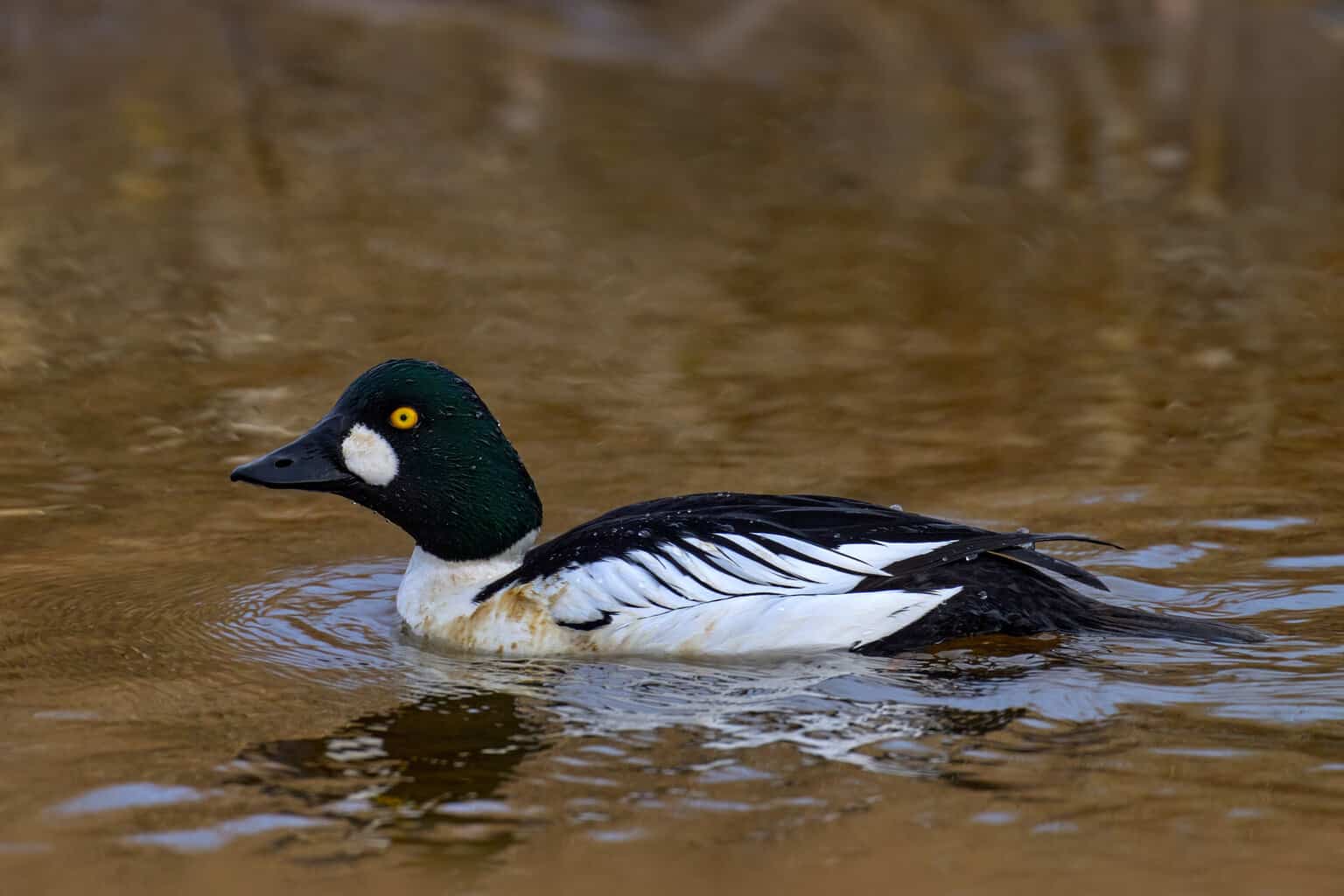
- Bucephala clangula
- Length: 16-20 inches
- Weight: Approximately 1.8 pounds
- Wingspan: 30.3-32.7 inches
Common Goldeneyes are abundant throughout all of Maryland. They live on the Chesapeake Bay and the surrounding rivers, typically in shallower waters that are no more than 5-20 feet deep.
While they are plentiful, they are not here for long. They arrive in the area in November and leave again in February.
Male Common Goldeneyes have black and white bodies, metallic green heads, and white wing patches. Their golden yellow eyes that give them their name are immediately recognizable.
Female Common Goldeneyes are brown. Her black bill has a yellow tip, and her eyes are golden yellow like his.
These ducks are also known for their aggression toward one another – especially the females. They will often fight each other, even when they have ducklings. The ducklings sometimes scatter during these fights and gather together in new groups that are called creches.
Common Merganser (Sea Duck)
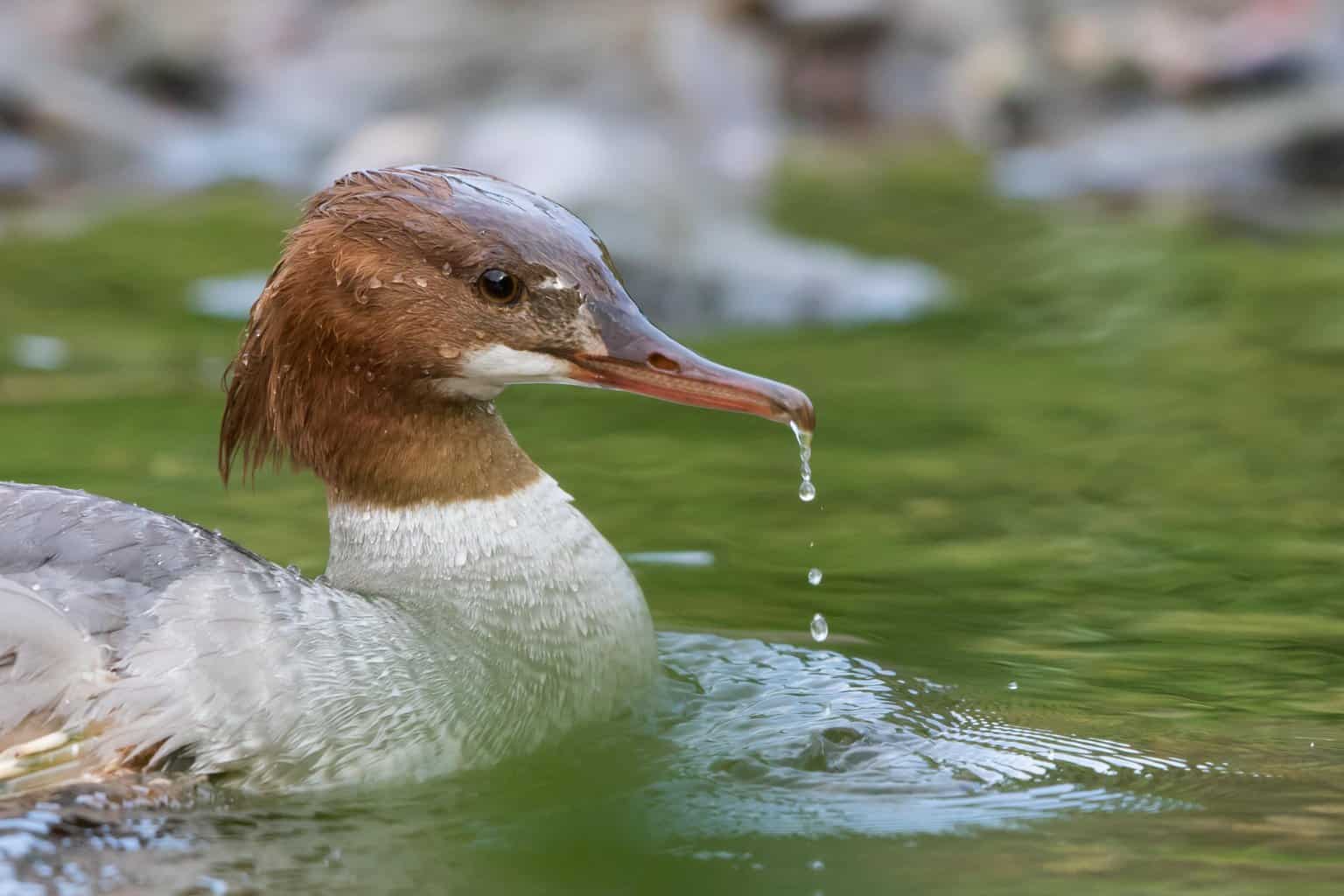
- Mergus merganser
- Length: 22 – 27 in (56 – 69 cm)
- Weight: 60.8 oz (1723 g)
- Wingspan: 31 – 37 in (79 – 94 cm)
Common Mergansers are common in Maryland throughout the winter. They tend to inhabit large lakes and reservoirs. You are most likely to find them in the Triadalphia and Loch Raven reservoirs or the Blackwater National Wildlife Refuge.
Common Mergansers males have a striking appearance. The male’s head is iridescent green, and he has a bright red bill and black eyes. He has a white belly and a black back.
The female Common Merganser’s head boasts a shaggy, reddish-brown crest. She is white-breasted and has a gray belly and back. Juveniles look like small versions of their mother.
These ducks have serrated bills, which allow them to tear into the flesh of their prey, which is mostly small fish but can also include mollusks, insects, frogs, worms, and some small mammals. You’ll see this serrated bill on all of the mergansers in our list.
Often, Common Mergansers are seen side-by-side with Buffleheads, as they share many of the same habitat preferences.
Gadwall (Dabbling Duck)
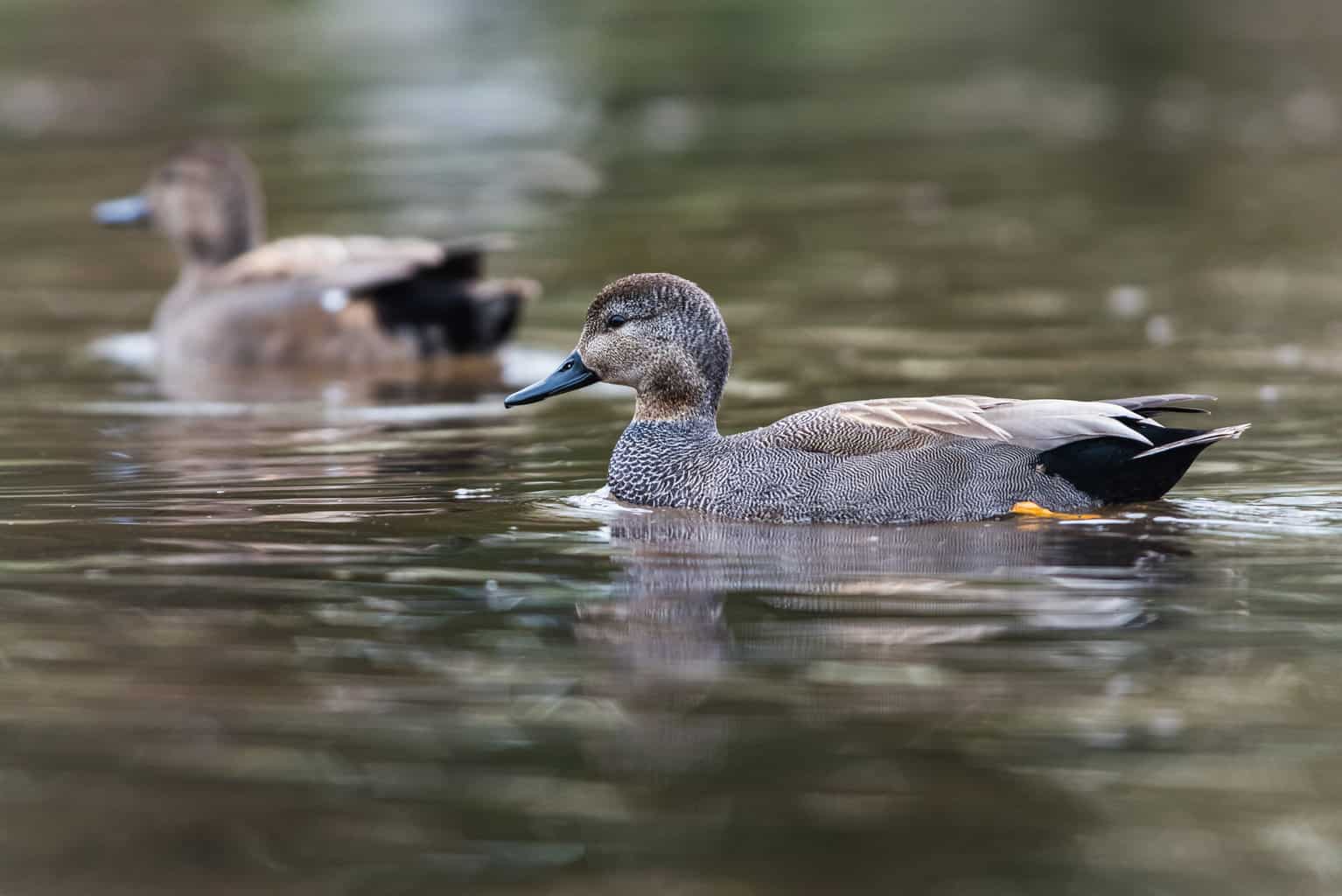
- Mareca strepera
- Length: 19 – 23 in (48 – 58 cm)
- Weight: 35.27 oz (1000 g)
- Wingspan: 31 – 36 in (79 – 91 cm)
Gadwall Ducks are widespread throughout Maryland. There have been sightings in Maryland as early as September, but they are much more likely to arrive in early November.
Most will leave by mid-May. They can be found in fresh and saltwater, including reservoirs, marshes, sewage ponds, and estuaries. They can also be spotted in city parks.
One of the reasons Gadwall are so plentiful is that they have high rates of breeding success.
Male Gadwall have a delicate scalloped pattern of black and gray. He has black tail feathers and a dappled, gray-brown head.
The female’s pattern is much larger. She is dark and light brown with an orange bill. Both sexes have white markings on their wings.
Greater Scaup (Diving Duck)
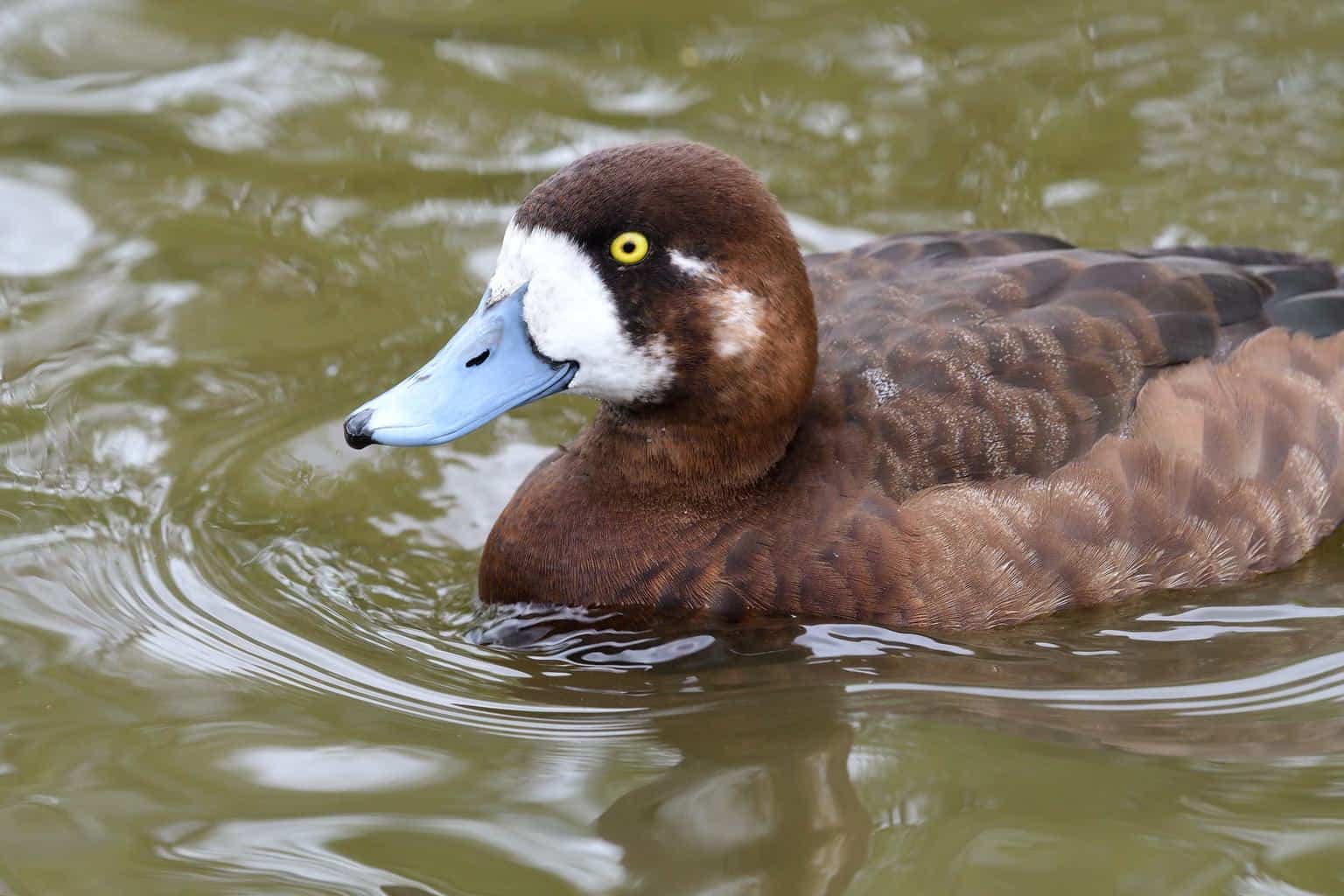
- Aythya marila
- Length: 15-22 inches
- Weight: 1.5-2.9 pounds
- Wingspan: 28-33 inches
Greater Scaup live in Maryland’s brackish waters along the east coast of the Chesapeake Bay, especially between Baltimore and Annapolis, exclusively during the winter. Their summer breeding territory spreads across the tundra of North America.
The male Greater Scaup has an iridescent green head in the breeding season, but they have brown heads while they are in Maryland for the winter. Their bodies are white with black and brown barring on the back.
Females have dark brown heads and light brown bodies. Their most distinctive feature is the thick pale ring around the base of her bill.
Green-Winged Teal Duck (Dabbling Duck)
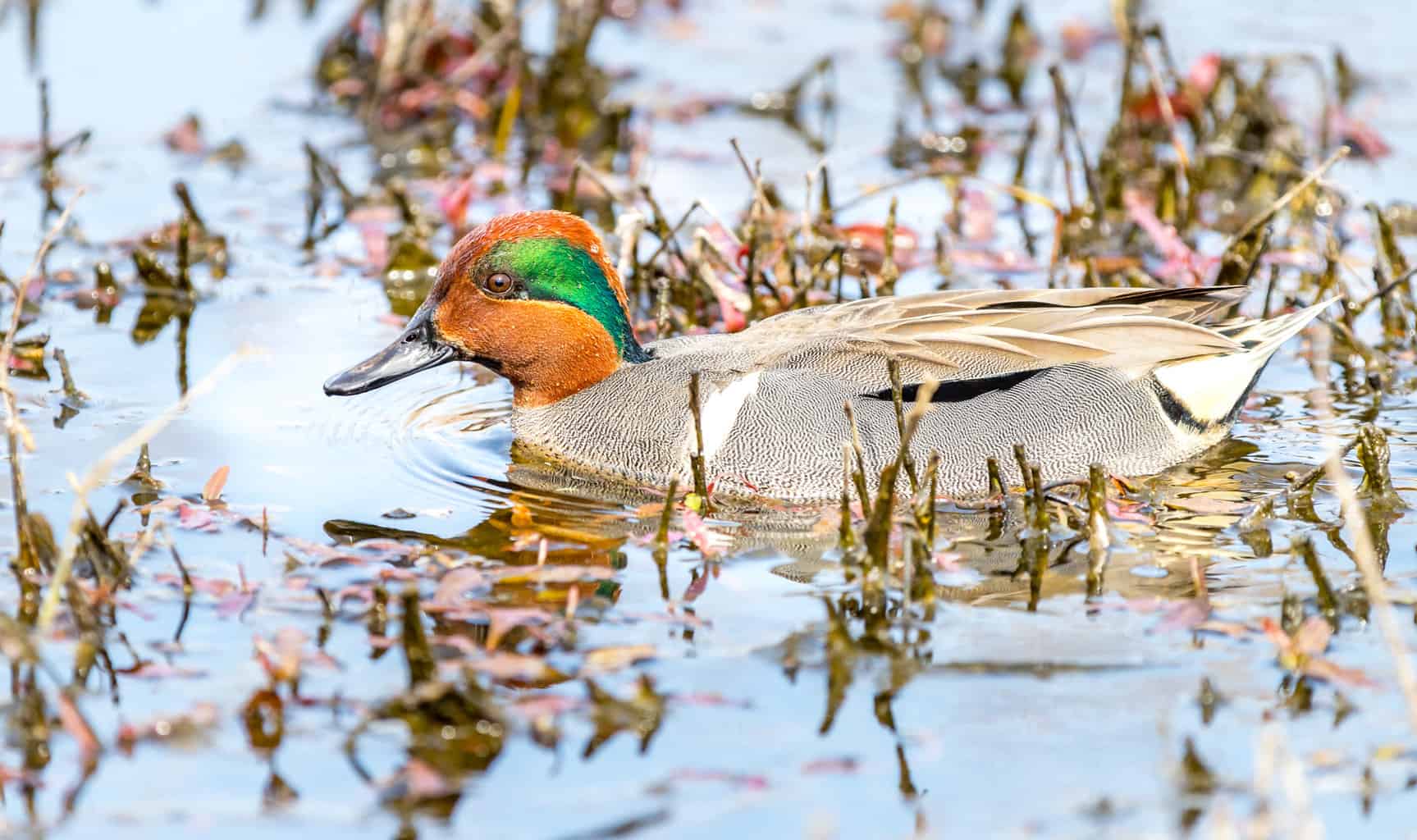
- Anas crecca
- Length: 12.2 – 15.3 in (31 – 39 cm)
- Weight: 4.9 – 17.6 oz (140 – 500 g)
- Wingspan: 20.5 – 23.2 in (52 – 59 cm)
The small Green-Winged Teal Ducks inhabit the Chesapeake Bay’s tidal marshes and rivers in the winter.
The male Green-Winged Teal Duck has a green stripe down both sides of his face, running from his eyes to the back of his head. His body looks gray from a distance, but up close, you will see small black barring on white feathers.
The female’s coloring is variegated from light to dark brown, and she has a yellow streak down her tail.
Males and females alike have an iridescent green speculum on their secondary wing feathers.
Green-Winged Teal Ducks have a long lifespan. They can take off directly from the water, without getting a running start.
Harlequin Duck (Sea Duck)
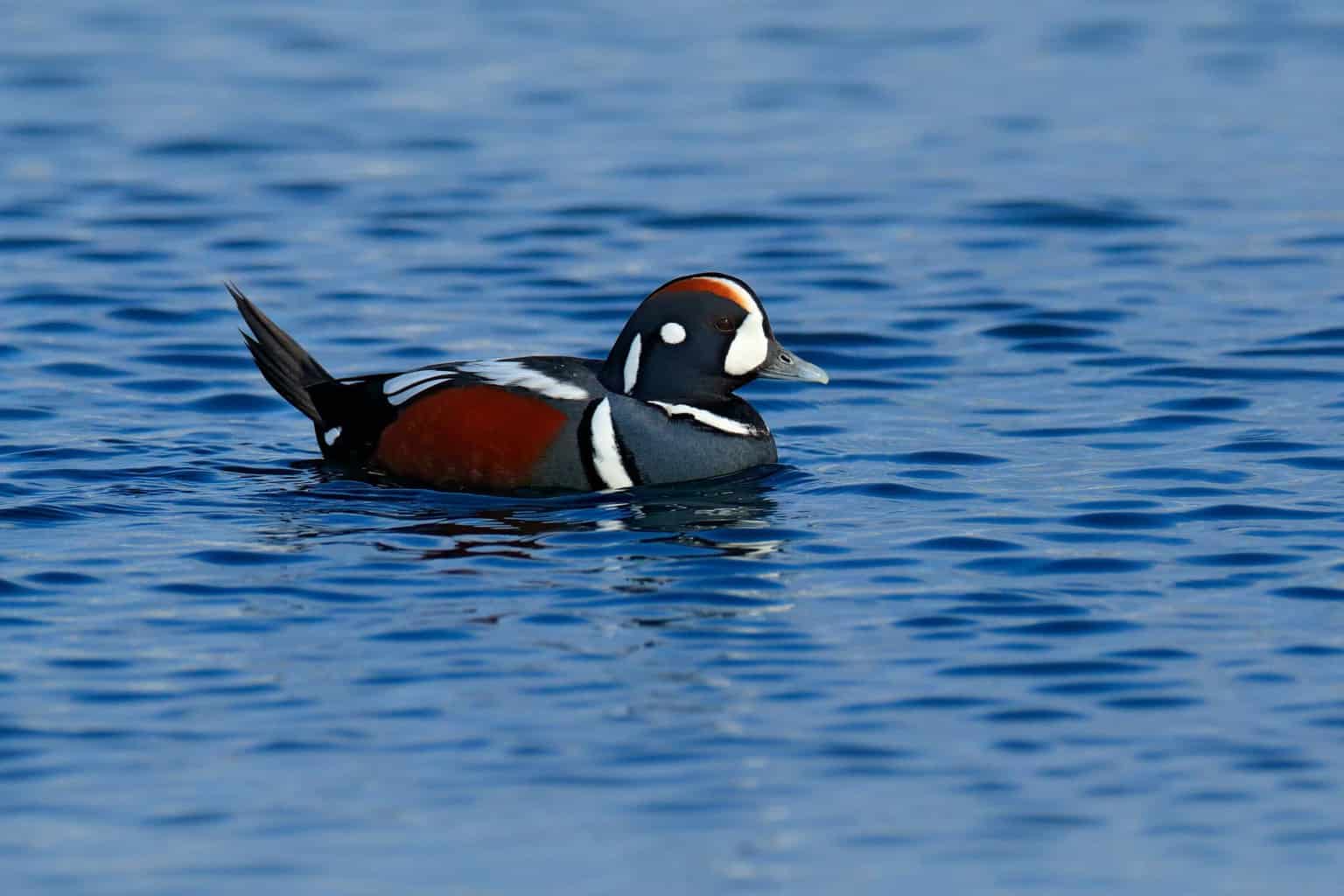
- Histrionicus histrionicus
- Length: 15 – 21 in (38 – 53 cm)
- Weight: 24 oz (680 g)
- Wingspan: 26 – 28 in (66 – 71 cm)
Harlequin Ducks are found throughout Maryland, but not in particularly large numbers. They are only present in the winter. They spend their time near jetties and piers on the coast, eating barnacles. Sometimes, they are thrown against the rocks and piers, which leads to broken bones and head injuries.
The male Harlequin Duck is dramatic in his coloring and pattern. He is slate blue with black-lined white stripes on his head, neck, and chest. A stripe at the top of his head is chestnut brown, as is a small section of his sides, under his wings.
The female has a similar body shape, but her coloring is completely different. She is dark brown and has a small white patch near the base of her neck.
The Harlequin Duck’s nickname is the Sea Mouse, thanks to the small, mouse-like sound they make. It’s easy to remember their nickname because they’re also quite small in stature!
Hooded Merganser (Diving Duck)
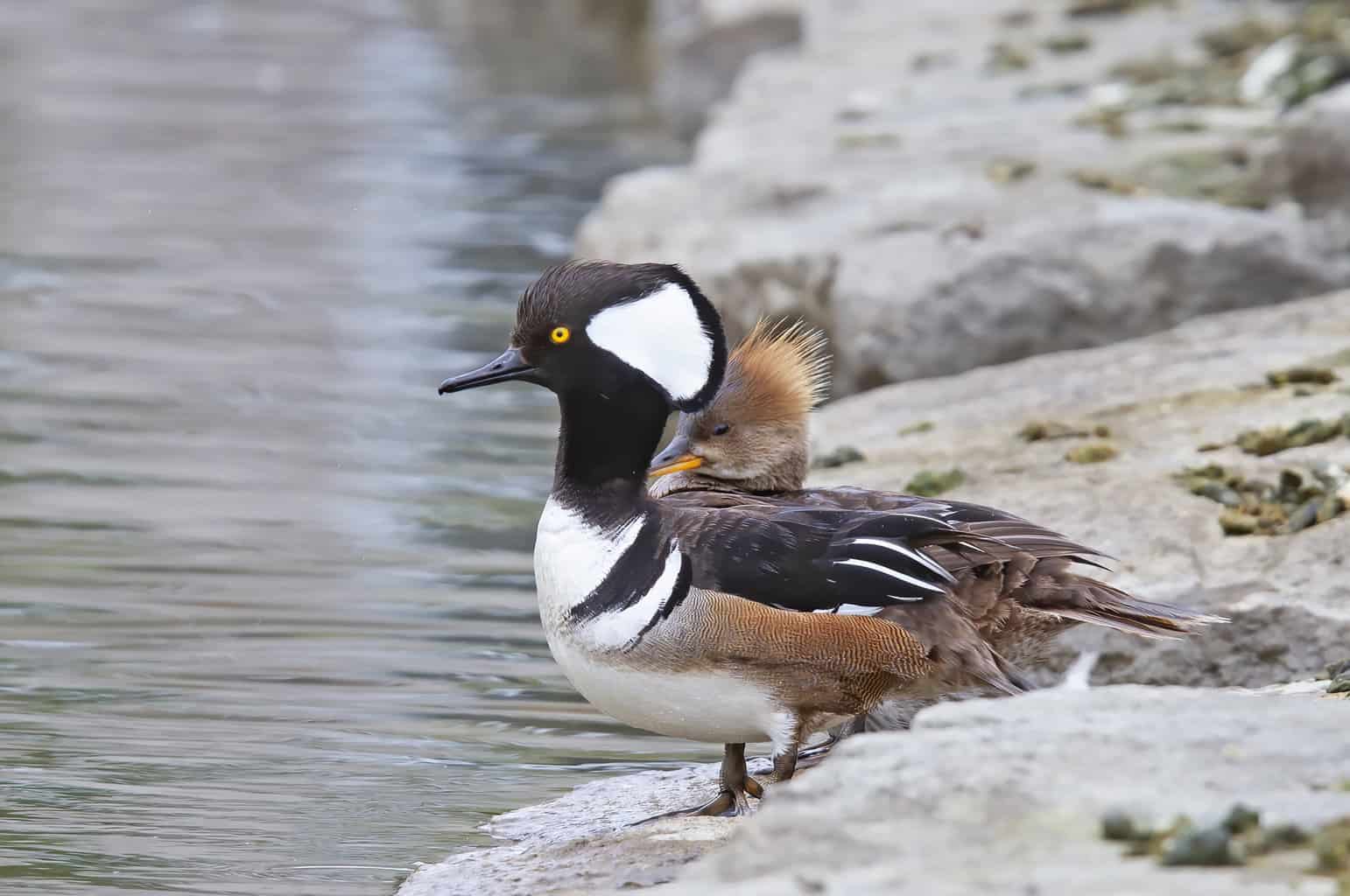
- Lophodytes cucullatus
- Length: 16 – 19 in (41 – 48 cm)
- Weight: 32.09 oz (909 g)
- Wingspan: 24 – 26 in (61 – 66 cm)
Hooded Mergansers are mostly winter residents of Maryland, although there have been a handful of sightings in the summer months. They winter in coastal estuaries and wooded wetlands, including swamps and ponds.
Both male and female Hooded Mergansers have a large, attention-grabbing crest. The male is black and white with brown sides, and he has a black and white crest that he raises and lowers.
The female’s crest is shaggy and cinnamon-brown. Her body lacks any other distinctive markings, but her bill has some orange coloration.
Hooded Mergansers have a diet of fish and crustaceans, which they rip apart with their strong bills. They also get their nickname of “frog-duck” from their unique vocalizations that sound like a croaking pickerel frog.
King Eider (Sea Duck)
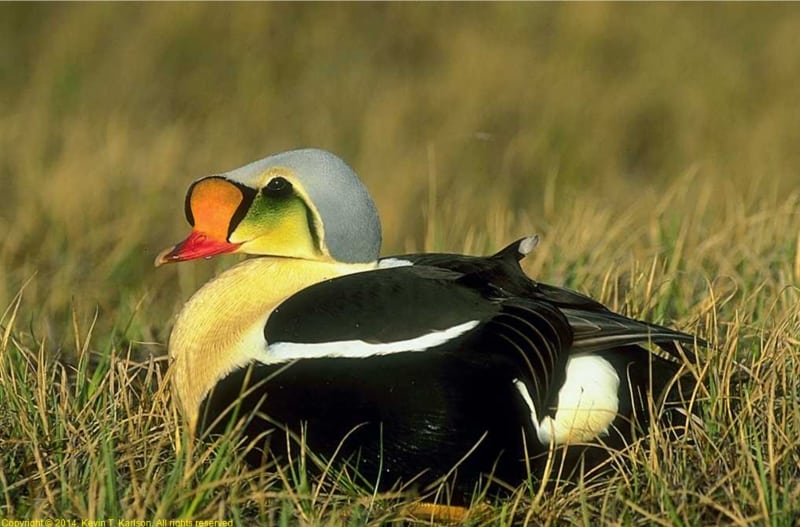
- Somateria spectabilis
- Length: 20 – 28 in (50 – 70 cm)
- Weight: 2.6 – 4.6 lb (1.2–2.1 kg)
- Wingspan: 34 – 40 in (86 – 102 cm)
King Eiders are rare in Maryland, but there have been confirmed sightings in the state. More sightings have occurred in the winter than in the summer.
They may be seen in small groups of six or seven, usually near a pier or jetty, as they are exclusively found in saltwater.
The King Eider has a unique head shape. The male’s head is oblong, and he has a sizeable orange plate above his bill that makes his forehead bulge. His body is white and black, and his crown is very light blue. He has a bright red bill.
The female King Eider is much plainer. She has a pale brown cheek and neck, a black bill, and a dark brown body with black markings. Like the male, she is large and has a thick neck.
Lesser Scaup (Diving Duck)
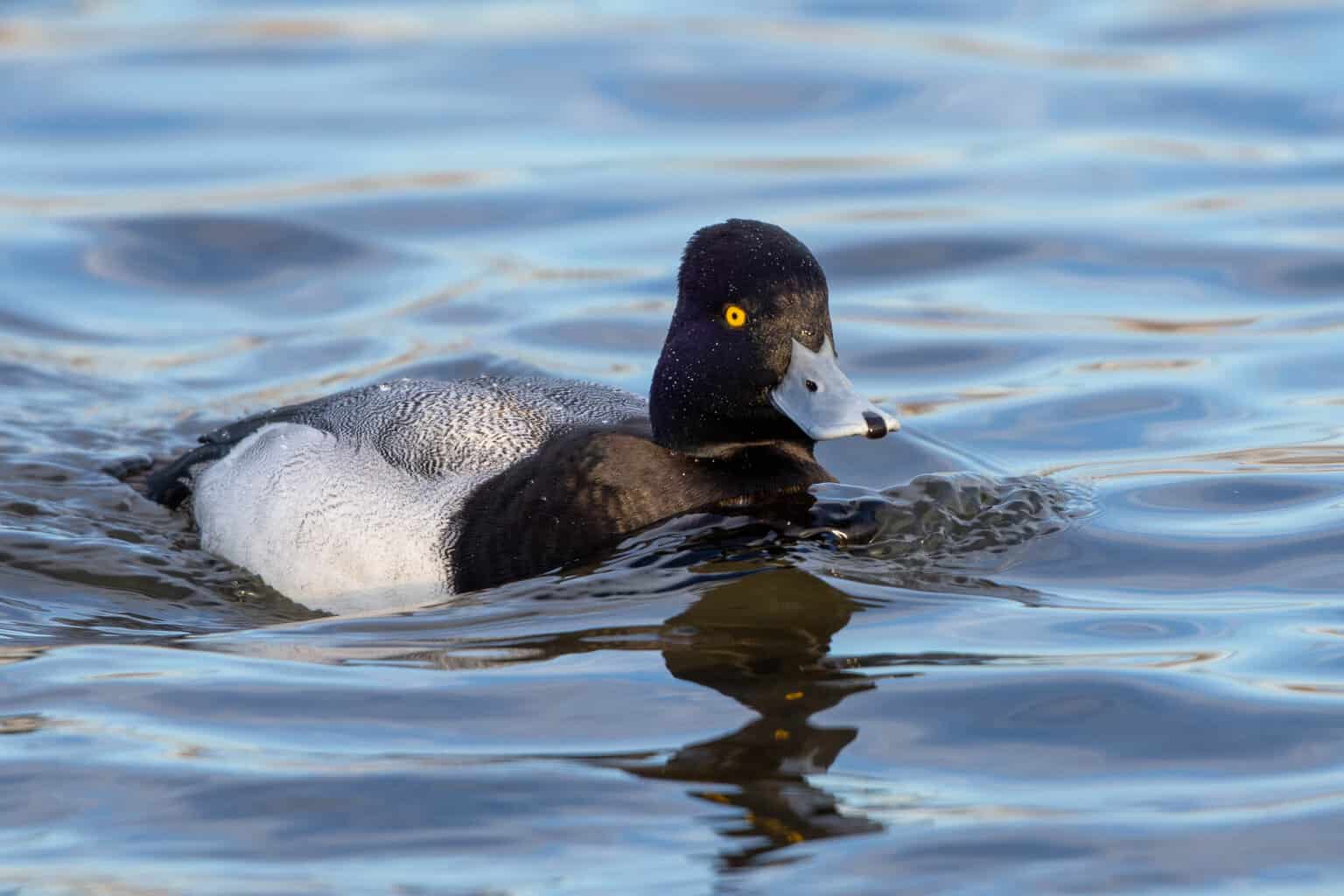
- Aythya affinis
- Length: 15 – 18 in (38 – 49 cm)
- Weight: 40.77 oz (1155 g)
- Wingspan: 24 – 33 in (61 – 84 cm)
You have a much higher chance of seeing a Lesser Scaup in the Chesapeake Bay area than a Greater Scaup. They winter throughout the state, especially on the Oakley Street waterfront in Cambridge, or on the Potomac River. They are often found in large flocks.
Lesser Scaup are similar to Greater Scaup in appearance. The male’s head is dark greenish-purple and iridescent, but it is sometimes mistaken as black from a distance. He has a barred body that is gray and white.
The female is dark brown. She has a white facial patch at the base of her bill.
One key to differentiating between Lesser and Greater Scaup is to look for the few stray “hairs” on the Lesser Scaup’s head. These wispy feathers create a very small crest that the Greater Scaup lacks.
In addition to being excellent at camouflage, Lesser Scaup are also known for playing dead. This helps them avoid predators.
Long-Tailed Duck (Sea Duck)
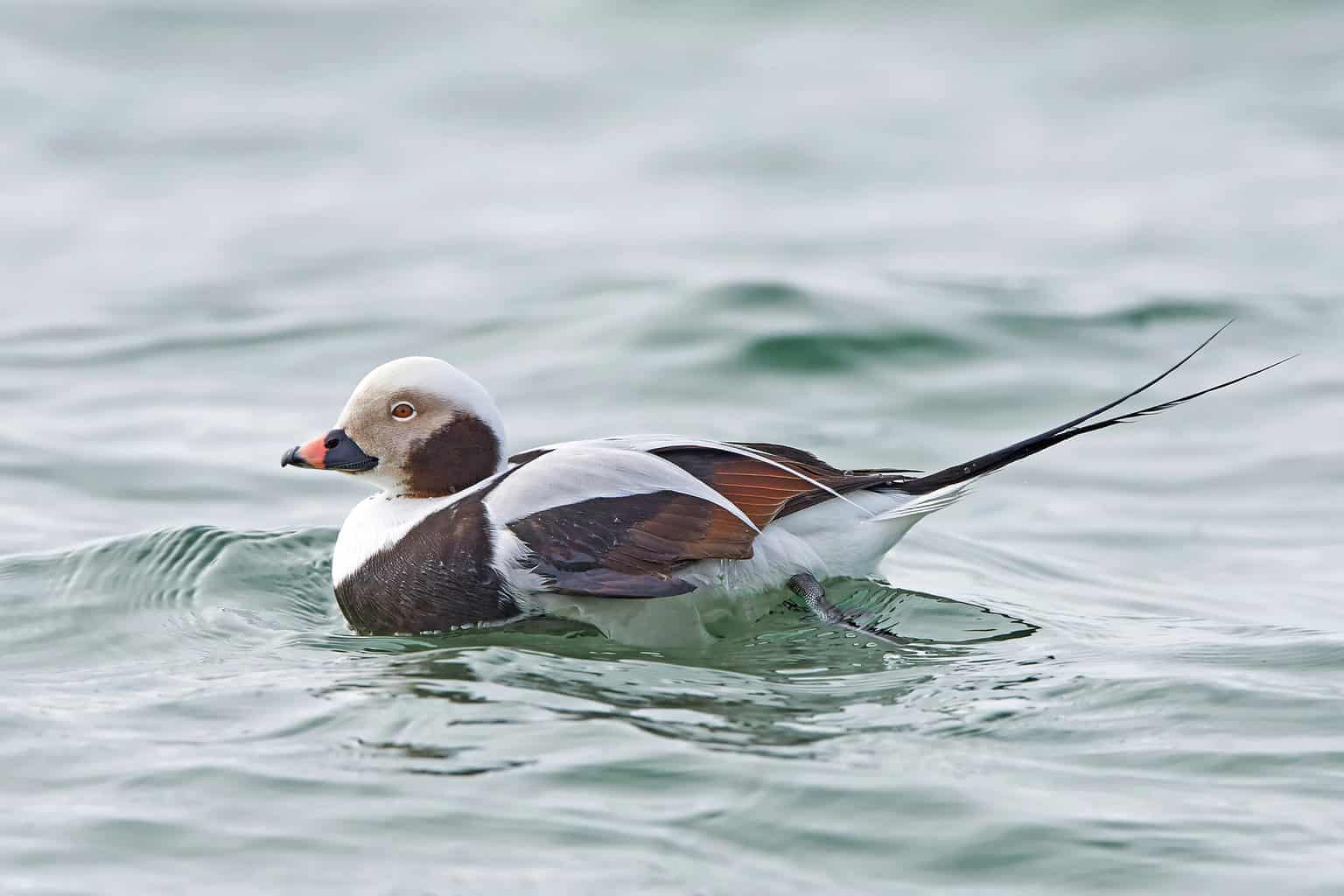
- Clangula hyemalis
- Length: 15 – 22 in (38 – 56 cm)
- Weight: 31.74 oz (900 g)
- Wingspan: 26 – 31 in (66 – 79 cm)
The Long-Tailed Duck has an elegant appearance. They live throughout Maryland, though their numbers are not as plentiful as other ducks in the state. They are winter-only residents.
Long-Tailed Ducks are known for their unusual mechanism of changing their appearance during the year. Plenty of ducks change their appearance, but Long-Tailed Ducks are pretty much the only ones who reverse their coloring altogether. Both males and females perform this “trick.”
In winter, when these ducks are in Maryland, the male’s shoulders, crown, neck, belly, back, and forehead are all white. He has a gray eye mask, and the rest of him is black: cheek patches, breast, tail feathers, and wings.
By summer, his breeding season coloring is reversed: the black feathers are now white, and the white feathers are now black.
Females have a white head and brown body in winter, but in the summer, they have a brown head and white body.
Mallard Duck (Dabbling Duck)
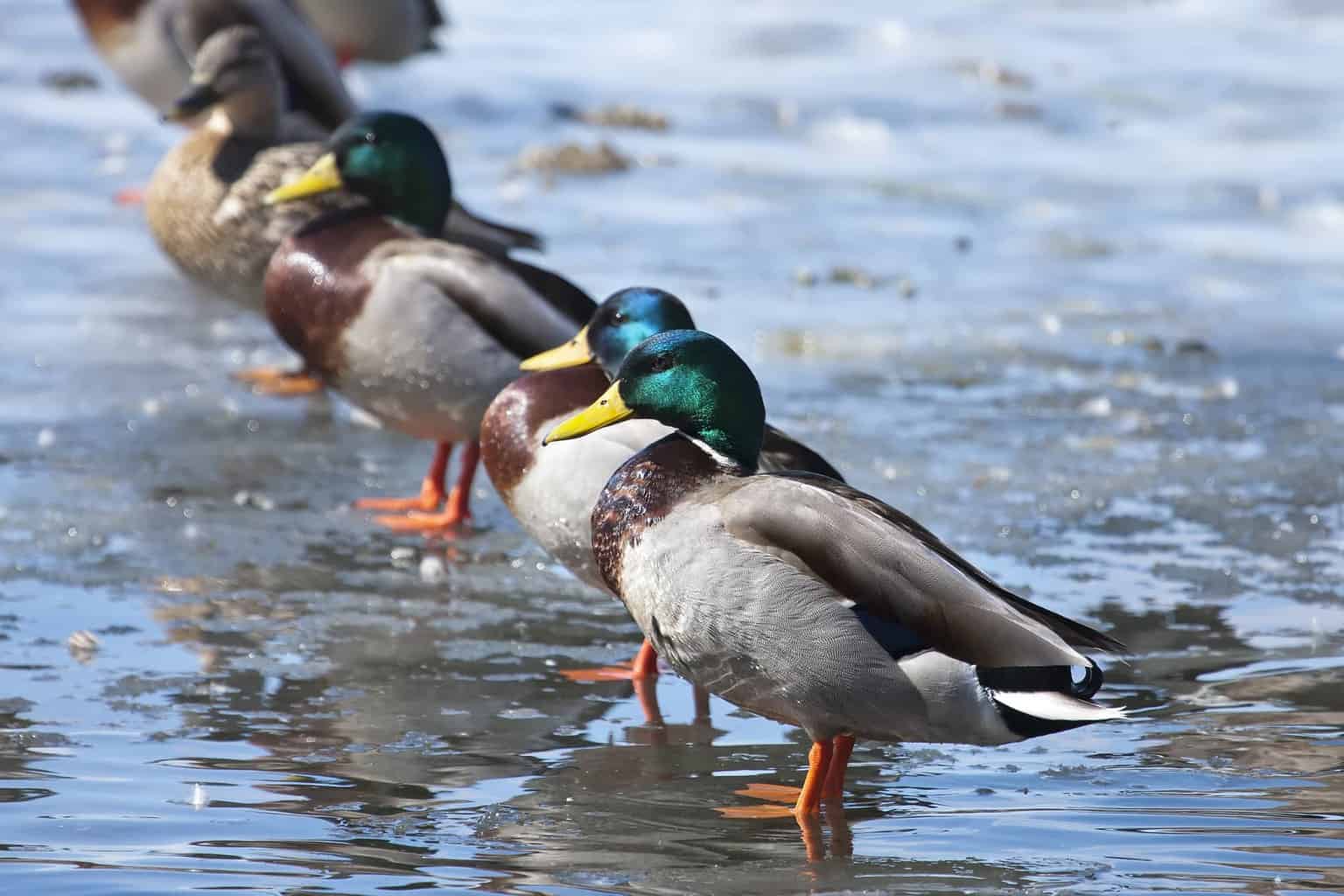
- Anas platyrhynchos
- Length: 19.7 – 25.6 in (50 – 65 cm)
- Weight: 35.3 – 45.9 oz (1000 – 1300 g)
- Wingspan: 32.3 – 37.4 in (82 – 95 cm)
Mallards are very common in Maryland, as they are widespread throughout most of the globe. They are one of the only ducks that can be found in Maryland year-round.
They are nighttime foragers whose diet includes seeds, roots, stems, and other plant parts. Mallards play an important role in Maryland’s wetlands, as they disperse seeds throughout the area based on their eating habits.
The iconic look of the male Mallard is unmistakable: his iridescent green head, gray body, white neck-ring, brown breast, blue speculum, and yellow bill make him immediately identifiable.
The female, who is usually with him, is streaked with various shades of brown. She has a light brown head and a multi-colored bill that is mostly orange with a black patch at both the top and tip.
Mallards are often represented in home decor, collector’s items, paintings, figurines, and kids’ toys.
- Squeeze, cuddle, repeat! Squishmallows are the softest, cutest plush toys around!
- Your new cuddle buddy awaits! Meet Avery the Mallard! Squishmallows have a style and personality all their own, encouraging fun...
- Snuggle up with the squishiest friend in town! These super soft, collectible plush toys make great cuddle companions! The squishy...
Last update on 2024-07-25 / Affiliate links / Images from Amazon Product Advertising API
As the most plentiful ducks in the world, it is easy to find Mallards in many different kinds of waters. That said, they avoid brackish marshes.
Northern Pintail (Dabbling Duck)
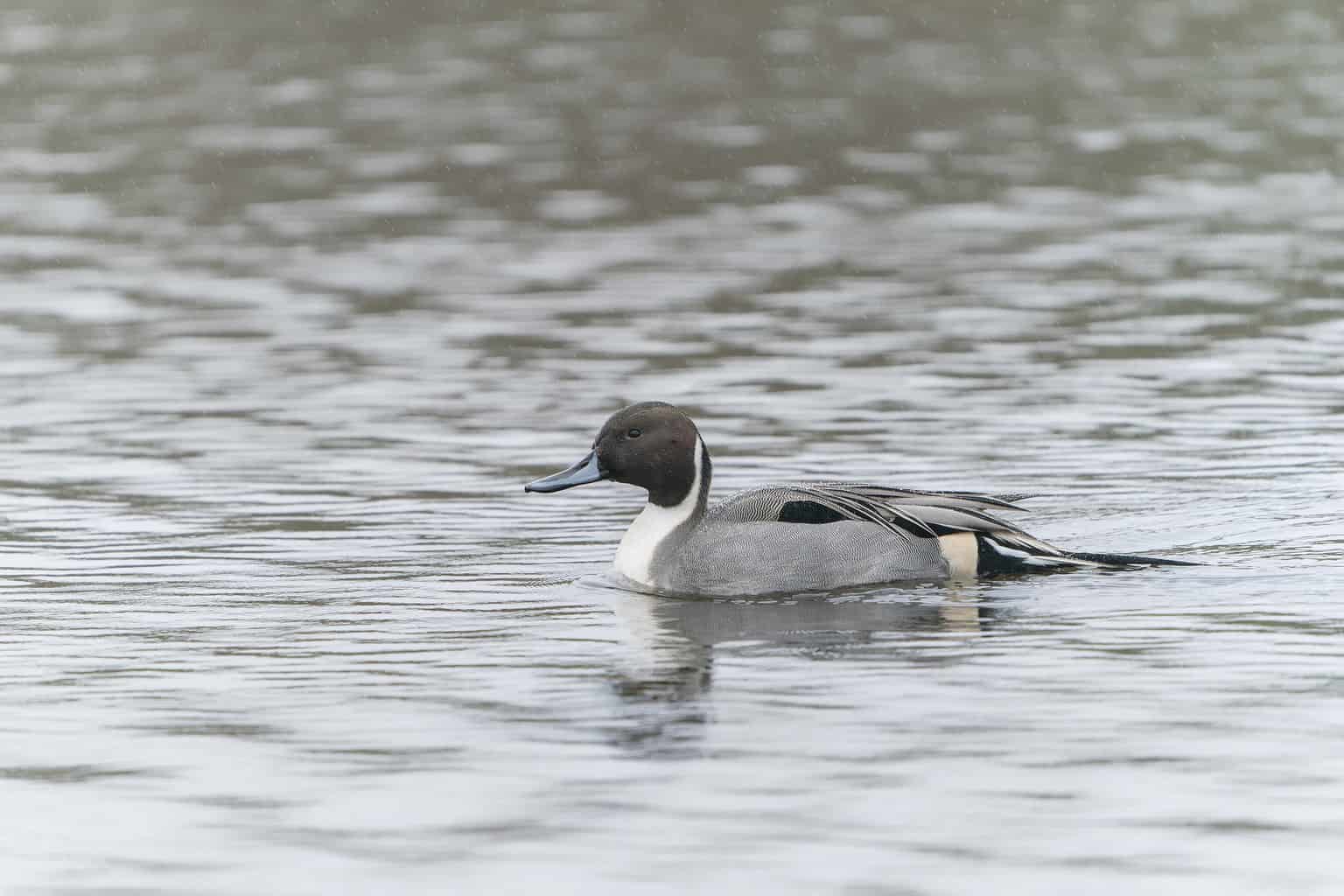
- Anas acuta
- Length: 20 – 26 in (51 – 66 cm)
- Weight: 36.33 oz (1030 g)
- Wingspan: 29 – 35 in (74 – 89 cm)
Northern Pintails live throughout Maryland in the winter. They are more likely to be found in the Chesapeake Bay area than in western Maryland. You are likely to find them in the state’s fresh or brackish marshes and lakes.
In the breeding season, male Northern Pintails have several long, pointy tail feathers, which fall off during their fall molting. Even so, their winter tail is still pointed enough to give them a noteworthy silhouette.
The male’s body is gray, brown, white, and black. He has a dark brown head with a white stripe running down his neck.
The female’s tail is also pointed, but shorter than the male’s. She has an intricate light and dark brown pattern all over her body.
The Northern Pintail’s diet consists mostly of seeds and grasses. They will also eat crustaceans and insects.
Northern Shoveler (Dabbling Duck)

- Spatula clypeata
- Length: 17.3 – 20.1 in (44 – 51 cm)
- Weight: 14.1 – 28.9 oz (400 – 820 g)
- Wingspan: 27.2 – 33.1 in (69 – 84 cm)
Northern Shovelers are found in Maryland exclusively in the winter. In Western Maryland, they are more likely to be migratory. Watch for them in saltwater lakes and tidal estuaries, as well as muddy wetlands and marshes.
Although Northern Shovelers aren’t solitary ducks, they are sometimes the only kind of duck around, as they are happy to inhabit muddy, stagnant waters that other ducks avoid.
Their feeding behavior is interesting to watch. Several dozen Northern Shovelers will group together and rotate at the same time, looking like a group of pinwheels. This spinning stirs up the water so that their favorite food is brought up from the bottom.
Northern Shovelers have a thick, spoon-shaped bill that widens at the tip. Inside the bill, the Northern Shoveler has a row of comb-like bristles that they use to filter food. The male’s bill is dark gray, and the female’s bill is yellowish-gray with orange edges.
The male’s head is iridescent green, and he has a white breast, a black back, and brown sides. His eyes are yellow.
The female has a mottled appearance in both light and dark brown. She has some light blue on her wings, as does the male.
Red-Breasted Merganser (Sea Duck)
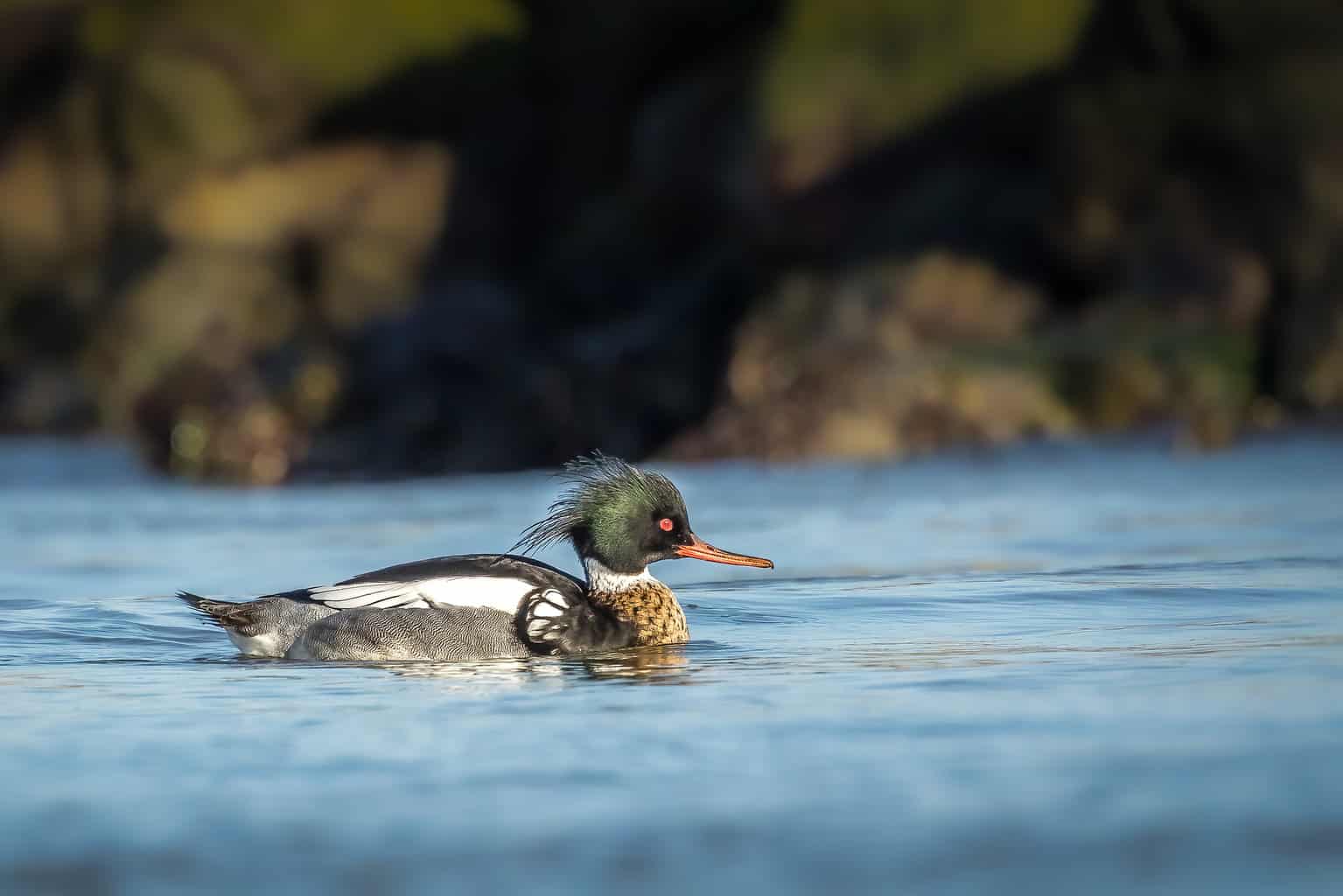
- Mergus serrator
- Length: 16 – 26 in (41 – 66 cm)
- Weight: 47.61 oz (1349 g)
- Wingspan: 31 – 35 in (79 – 89 cm)
Red-Breasted Mergansers are found in Maryland’s coastal waters during the winter, including the Chesapeake Bay. The majority of sightings have been near Ocean City. They are incredibly fast ducks, flying up to 81 miles per hour!
Male Red-Breasted Mergansers have a spiky or shaggy crest on the back of their heads. Their serrated bills are long, thin, and orange. The male’s head is dark green, and he has a white ring around his neck, as well as a brown chest and gray sides.
The female’s crest and head are reddish-brown, and she has a white throat. Her crest is not as long as the male’s, but her bill looks just like his.
The Merganser’s serrated bill is used to tear apart small fish, tadpoles, insects, and crustaceans.
Redhead Duck (Diving Duck)
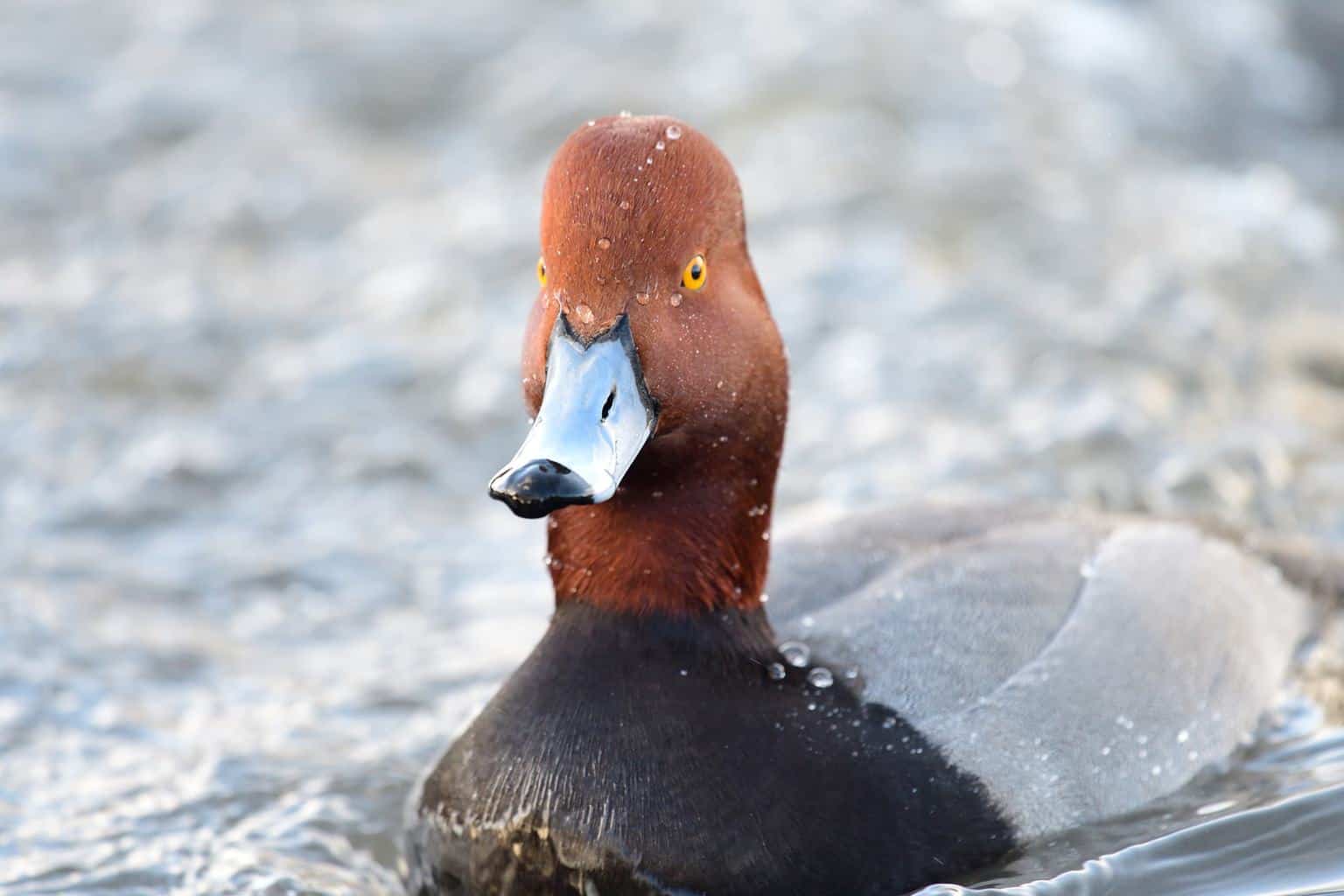
- Aythya americana
- Length: 18 -22 in (46 – 56 cm)
- Weight: 43.03 oz (1219 g)
- Wingspan: 29 – 35 in (74 – 89 cm)
Redheads arrive in Maryland much later in the fall than other migratory ducks. Most arrive in late November and leave as early as the end of March.
They are commonplace throughout the state, with some concentration in the Chesapeake Bay area and surrounding waters.
Male Redheads have round, coppery-brown heads. His feet are blueish-gray, and his bill is pale blue with a black tip and a white band. He has orange eyes, and his chest and tail are black. His back is gray, and he is white-breasted.
Female Redheads are similarly patterned, but their coloring is less dramatic. They have a brownish-yellow head, brown eyes, and a mostly gray body. In Maryland, you will see their winter coloring, which is darker overall.
Redheads practice brood parasitism, which is the act of laying their eggs in a few different ducks’ nests. They lay their own eggs and raise them, but this practice also increases their chances of reproductive success.
Ring-Necked Duck (Diving Duck)
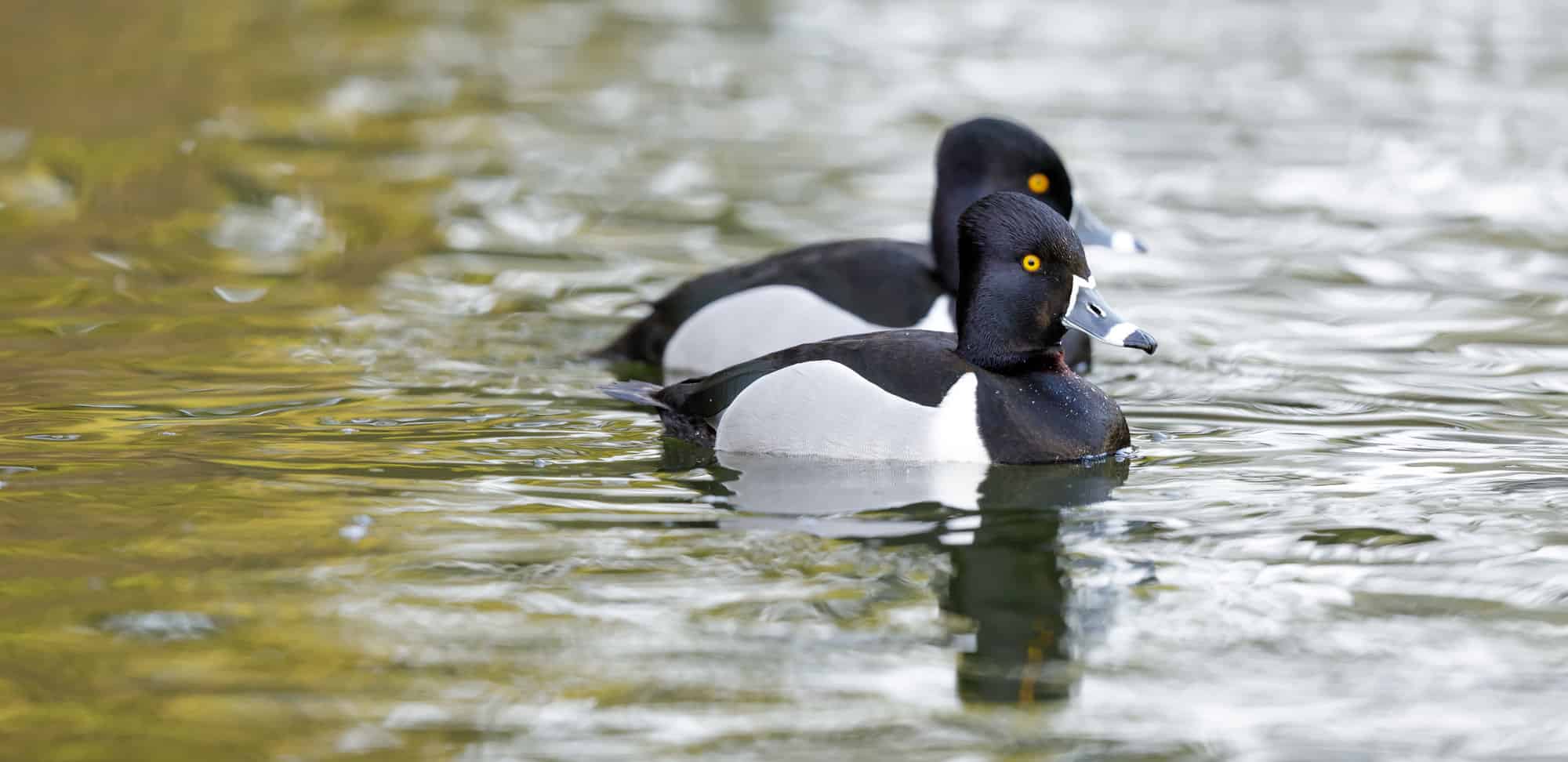
- Aythya collaris
- Length: 14 – 18 in (36 – 46 cm)
- Weight: 32.09 oz (909 g)
- Wingspan: 24 – 30 in (61 – 76 cm)
Ring-Necked Ducks are mostly winter residents of Maryland, but they have been spotted on rare occasions in the summer. Their numbers are especially high right outside of Washington, D.C.
Even though they are called the Ring-Necked Duck, the copper ring around their neck is barely visible – especially from any distance. It blends into the dark black feathers of the duck’s head, neck, and back.
The male does have a ring around his bill, and a white line that outlines the base of his bill.
Females are brown-bodied, and they have a white band near the end of their bill.
Ring-Necked Ducks have a preference for shallow waters. They avoid deep lakes and rivers and are often found alongside Greater and Lesser Scaup.
Ruddy Duck (Diving Duck)
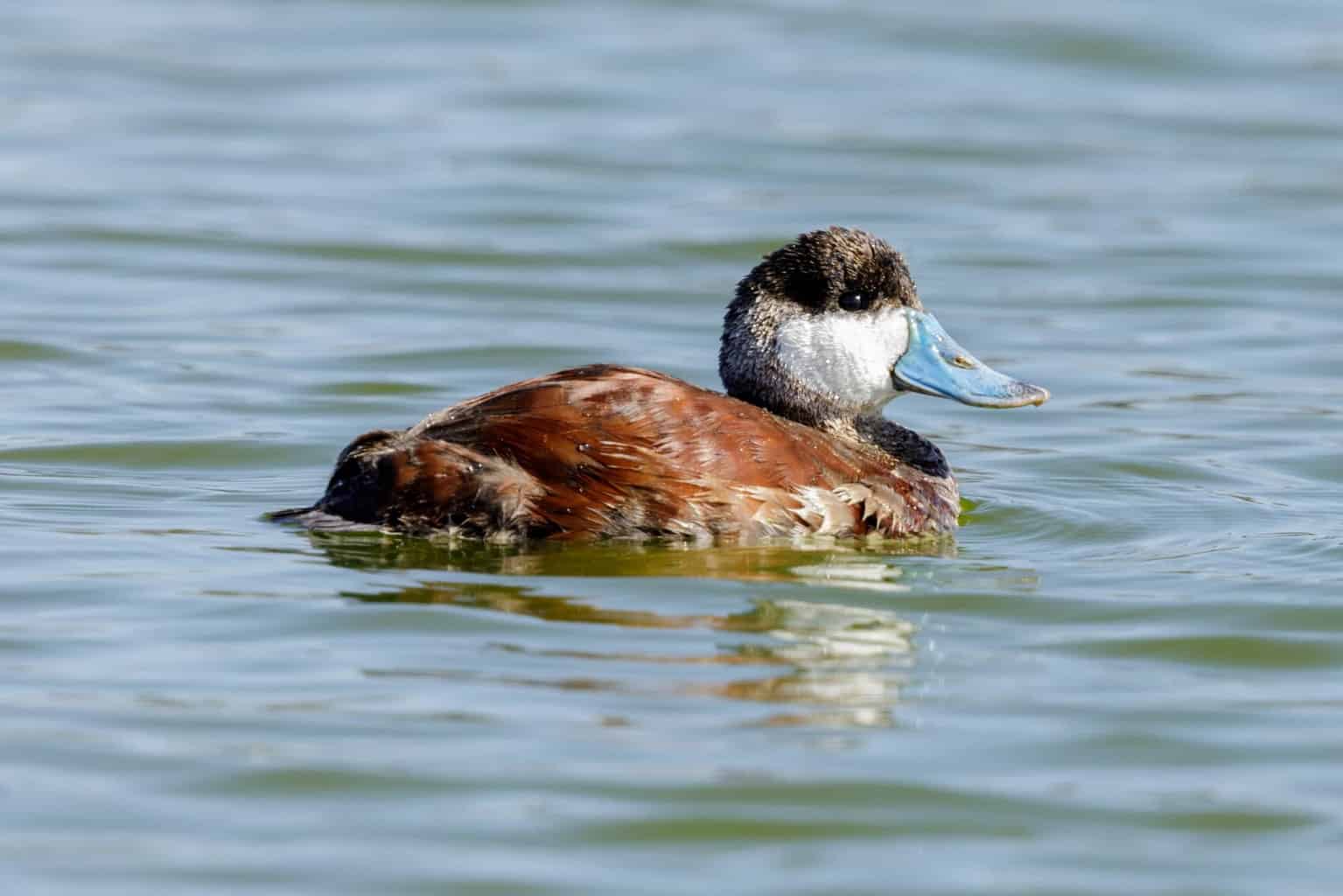
- Oxyura jamaicensis
- Length: 14 – 16 in (35.56 – 40.64 cm)
- Weight: 28.04 oz (795 g)
- Wingspan: 21 – 24 in (53 – 61 cm)
Ruddy Ducks are most common in Maryland during the non-breeding season, but they have also been sighted on occasion in the summer months. They are found in shallow coastal bays and estuaries. Inland, they winter on ice-free lakes.
Breeding season Ruddy Duck males are mostly dark brown, but they have a black head with a large white patch on their cheeks. Their bill is thick and light blue. When they molt for the winter, their coloring is mostly dull gray.
Female Ruddy Ducks are dappled in brown. Their cheek patches are gray, their bills are black. The bulky appearance of the Ruddy Duck gives it the nickname “the bull-necked teal.”
Ruddy Ducks are quite tame and unafraid of people. They hide their nests in the dense aquatic grasses along the edges of freshwater marshes and ponds. They nest only a few inches from the water’s edge.
Surf Scoter (Diving Duck)
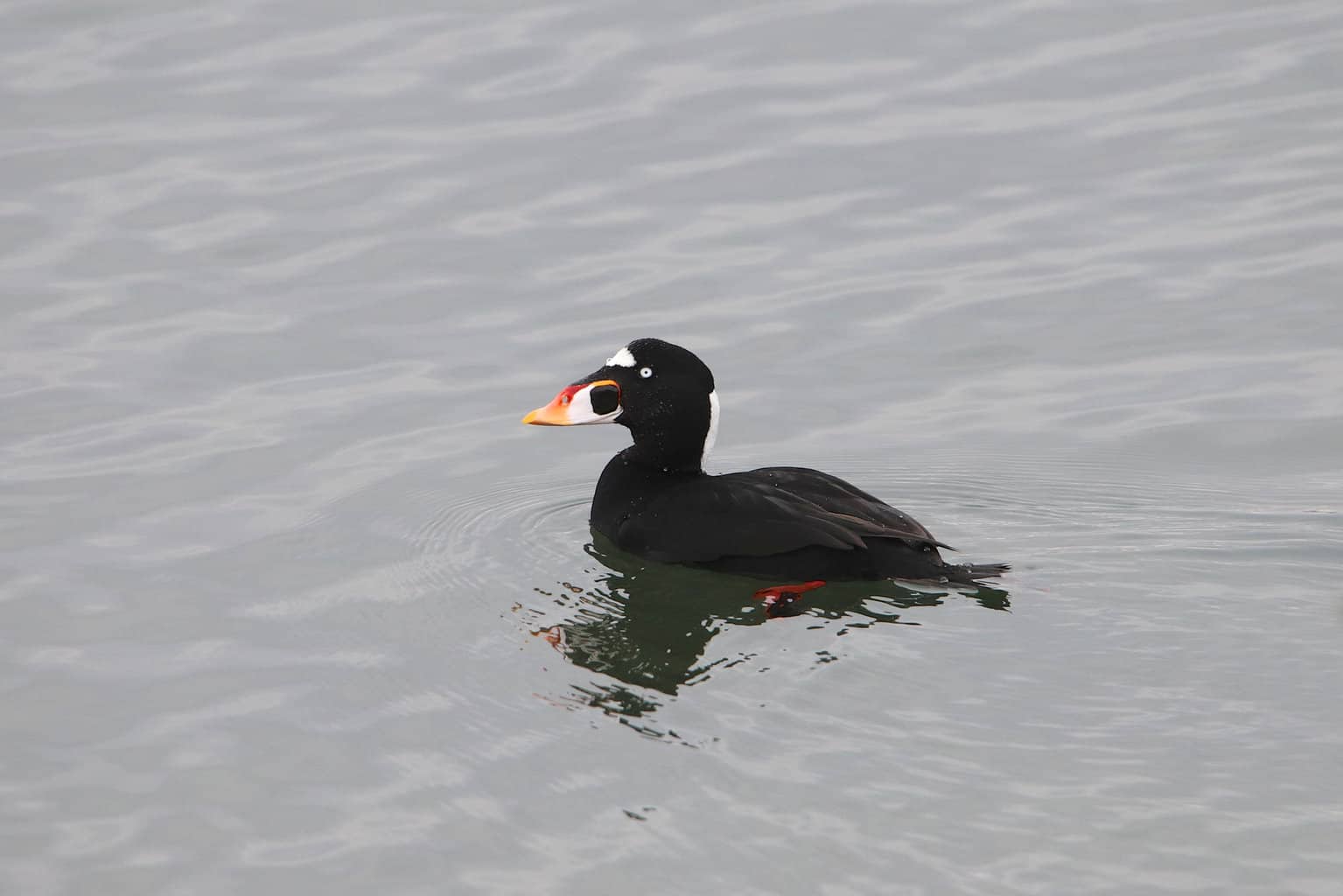
- Melanitta perspicillata
- Length: 17 – 21 in (43 – 53 cm)
- Weight: 35.27 oz (1000 g)
- Wingspan: 30 – 36 in (76 – 91 cm)
Maryland’s Surf Scoters arrive around October, stay for the winter, and leave by early April.
Thanks to the Chesapeake Bay, Maryland sees Surf Scoters farther inland than most other coastal states where they spend the winter. Still, they are most common around the Bay, especially outside of Ocean City, Annapolis, Cambridge, and Easton.
You can easily identify a Surf Scoter because of his huge, colorful, knobbed bill and sloping forehead. He is black-bodied and has white spots on his bill and at the base of his neck.
Females are smaller, and their bill lacks the dramatic coloring of the male’s bill. She has a dark gray body and white patches on the back of her neck and behind her eyes.
White-Winged Scoter (Sea Duck)
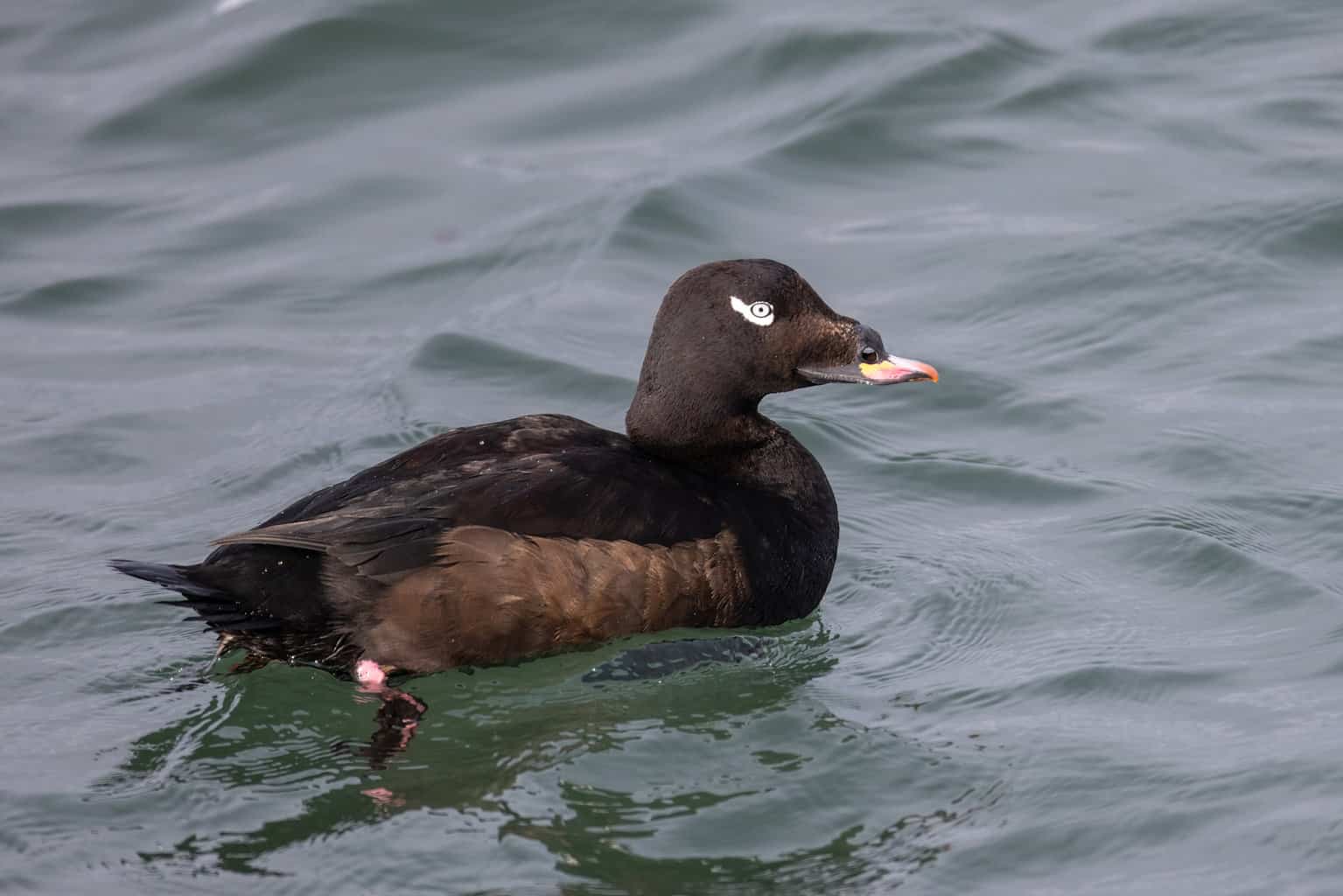
- Melanitta deglandi
- Length: 19 – 24 in (48 – 61 cm)
- Weight: 62.4 oz (1768 g)
- Wingspan: 33 – 41 in (84 – 104 cm)
White-Winged Scoters are sea ducks who rarely stray from the coast. They winter in Maryland’s Chesapeake Bay, with the biggest concentration of sightings near Ocean City.
White-Winged Scoters, like other scoters, have a thick, uncommonly-shaped bill. The male White-Winged Scoter is mostly black, and he has a white comma-shaped marking over each eye. His wings have a long white stripe.
Females have a very similar look; their coloring is just slightly lighter. The females don’t have the eye marking, but they have a small white patch on their cheeks.
Wood Duck (Dabbling Duck)
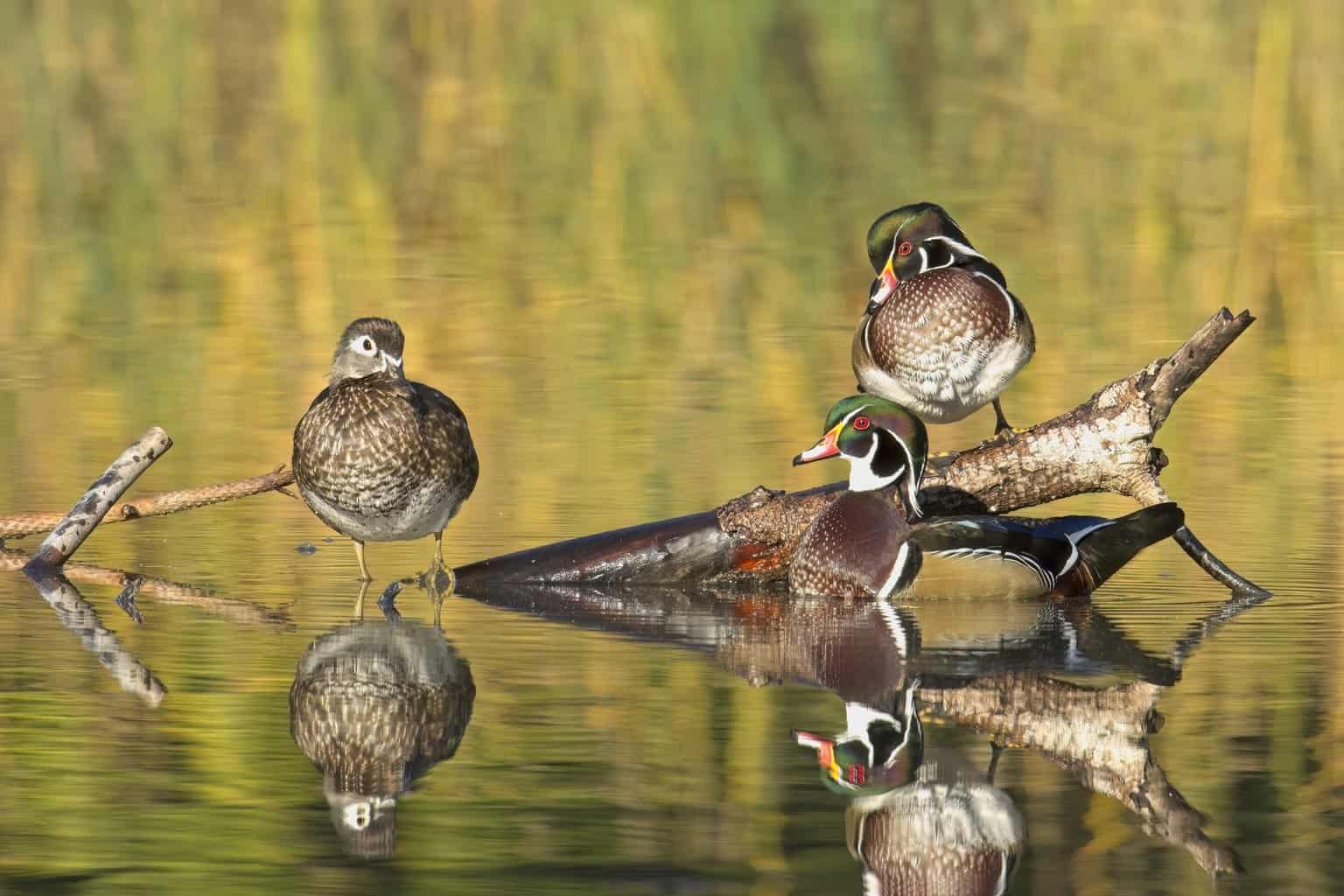
- Aix sponsa
- Length: 18.5 – 21.3 in (47 – 54 cm)
- Weight: 16.0 – 30.4 oz (454 – 862 g)
- Wingspan: 26.0 – 28.7 in (66 – 73 cm)
The Wood Duck is one of Maryland’s only nesting-season ducks! If you see ducklings in Maryland, there is a good chance they are Wood Ducks.
They build their nests in tree cavities, usually in swampy areas throughout the whole state. They tend to hide among the trees in order to avoid predators. Some Wood Ducks will stay in the state all year, but others will migrate south for the winter.
The male Wood Duck is multi-colored and vibrant. His crested head is iridescent green and black with white stripes. He has brown sides, and his chestnut brown breast is dappled with tiny, cream-colored spots.
His bill is very colorful – it is black, white, orange, and yellow. He also has white stripes on his sides, back, and tail.
Females are plainer. They have a small crest, brown head, and brown body with pretty blue, white, and purple on their wings.
Good Luck Spotting Ducks in Maryland!
Spotting ducks in Maryland isn’t difficult, especially if you are close to the Chesapeake Bay or on the Atlantic Coast.
The trick is learning to identify each one! You may want to utilize some helpful tools, like spotting scopes and binoculars.
While you’re paying attention to ducks, don’t forget to take a look at some of the state’s other gorgeous birds. You can learn more in our visual guide to Maryland’s bird life.
Good luck and have fun!

